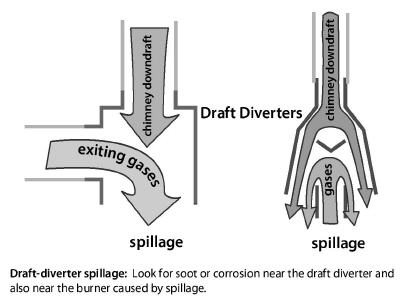
Chapter 8: Heating and Cooling Systems
This chapter discusses safety and energy-efficiency improvements to heating and cooling systems. It is divided into these main sections.
1. Essential combustion-safety testing
2. Heating-system replacement:
3. Servicing gas and oil heating systems
4. Combustion venting
5. Heating distribution systems
6. Air-conditioning systems
The SWS requires that weatherization agencies perform a combustion-safety evaluation as part of each weatherization work scope. This evaluation is the chapter’s first topic. The chapters other topics are procedures and requirements related to cost-effective ECMs, such as tune-ups and equipment replacement.
Qualified heating technicians should perform the installations, adjustments, and maintenance described in this chapter.
Important Note: Use manufacturer’s specifications and instructions whenever they are available. Many of the specifications in this chapter assume that the manufacturer’s instructions aren’t available. We offer numbers and other specific guidance that experts and reviewers consider correct.
8.1 HVAC-System Commissioning & Education
HVAC commissioning is the process of inspecting, testing, a system and educating occupants, landlords, and building operators to achieve the following goals.
8.1.1 HVAC-System Commissioning
|
SWS Details: 5.3102.38 Full Commissioning,5.3003.6 Evaluating Sequence of Operation, 5.3002.12 Cooling Equipment—Installation, Maintenance, and Commissioning— Mid and High Rise |
✓ Verify that the HVAC system works as the manufacturer, designer, and installer understand that it should work, based on plans, specifications, and manufacturers’ literature.
✓ Take appropriate measurements to verify that the HVAC system works safely and efficiently.
✓ Verify that the building owner or building operator understands the HVAC system’s operation and has the necessary system documentation.
✓ Verify that the building owner or building operator understand the procedures and schedule for routine maintenance.
There are three (3) types of commissioning.
1. Retro-commissioning, is commissioning implemented on existing HVAC equipment in an existing building.
2. Initial commissioning occurs during installation of a new HVAC system.
3. Re-commissioning is commissioning HVAC systems, that were already commissioned during original HVAC-system installation.
This chapter strives to provide the essential information for commissioning HCVAC systems. However, this information isn’t a substitute for plans, specifications, and manufacturers’ literature that should guide all HVAC installations. Searching for the HVAC system’s documentation is an essential first step in retro-commissioning or recommissioning.
|
SWS Details:2.0702.3 Building Operations Staff Education, 5.3003.7 Occupant Education |
Homes and multifamily buildings are complex systems of building envelopes and mechanical systems that harbor a variety of hazards. Educate occupants, landlords, and building operators about the health and safety hazards and the improvements that you make to mitigate these hazards.
✓ Explain equipment operation and maintenance (O&M).
✓ Provide a O&M procedures manuals and manufacturers’ equipment specifications. Encourage occupants or staff to store important documents in a safe and obvious location.
✓ Instruct occupants or staff to remove combustible materials from near ignition sources.
✓ Inform occupants and staff about smoke alarms, carbon monoxide (CO) alarms, and combination alarms, and explain their functioning.
✓ For complex mechanical systems in multifamily buildings, provide signs to inform occupants and building operators about operations, maintenance, and emergency procedures.
8.2 Combustion-Safety Evaluation
|
SWS Detail: 2.0103.1 Combustion Worker Safety, 5.3003.14 Combustion Analysis of Gas-Fired Appliances (LP and Natural Gas), 5.3003.2 Combustion Analysis of Oil-Fired Appliances |
At a minimum, evaluate the combustion safety at the weatherization job’s completion.
8.2.1 Combustion-Safety Observations
Make the following observations before testing to help you determine the likelihood of carbon monoxide (CO) and spillage problems.
✓ Recognize soot near the draft diverter, barometric damper, or burner of a combustion appliance as a sign that the appliance has produced CO and spilled combustion gases.
✓ Recognize that rust in a chimney or vent connector may also indicate spillage.
✓ Look for irregularities and flaws in the venting system.
✓ Specify that workers seal all accessible return-duct leaks attached to combustion furnaces.
✓ Verify that the home has a working CO alarm. If the home has no working smoke alarm in addition to no CO alarm, install a combination CO-smoke alarm, or separate CO and smoke alarms.

Natural gas and propane piping systems may leak at their joints and fittings. Find gas leaks with an electronic combustible-gas detector, also called a gas sniffer. A gas sniffer finds significant gas leaks if used correctly.
✓ Sniff all valves and joints with the gas sniffer. If a pressure test is done, sniff testing isn’t required.
✓ Accurately locate leaks using a noncorrosive bubbling liquid, designed for finding gas leaks.
✓ Repair all bubble-producing gas leaks or label them for a gas service person to seal.
✓ Replace kinked, cracked, or corroded flexible gas connectors.
✓ Replace flexible gas lines manufactured before 1973. The line’s manufacture date is stamped on a date ring attached to the flexible gas line or on the body of the hex nut. If a date ring isn’t present and you believe the gas line predates 1973, then replace the flexible gas line.
Caution: Do not pull out gas ranges to check gas lines.
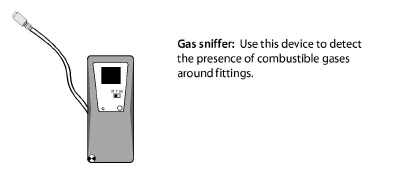
8.2.3 Carbon Monoxide (CO) Testing
CO testing is essential for evaluating the safety of combustion and venting. Measure CO in the flue gas of every combustion appliance you inspect and service. Measure CO in ambient air in both the home and CAZ as part of inspection and testing of combustion appliances.
Vent Testing for CO
Testing for CO in the appliance vent is a part of combustion testing that happens under worst-case depressurization conditions. The DOE and BPI have two separate CO limits depending on the type of appliance. If the following CO limits are exceeded in the undiluted combustion byproducts, the appliance fails the CO test under current DOE and BPI standards.
• Space heaters and water heaters: 100 ppm as measured or 200 ppm air-free
• Furnaces or boilers: 200 ppm as measured or 400 ppm air-free
Ambient Air Monitoring for CO
The DOE SWS require monitoring of CO during combustion testing to ensure that CO in the combustion appliance zone (CAZ) doesn’t exceed 35 ppm as measured. If ambient CO levels in the combustion zone exceed 35 ppm, stop testing for your own safety. Ventilate the CAZ thoroughly before resuming combustion testing. Investigate indoor CO levels, greater than outdoor ambient levels, to determine their cause. See Causes of Carbon Monoxide (CO)
8.2.4 Worst-Case CAZ Depressurization Testing
|
SWS Detail: 2.0103.1 Combustion Worker Safety, 2.0201.1 Combustion Appliance Zone (CAZ) Testing, 2.0201.2 Combustion Safety - Make-up Air, 2.0201.3 Vented Combustion Appliance Safety Testing |
CAZ depressurization is the leading cause of backdrafting and flame roll-out in furnaces and water heaters that vent into naturally drafting chimneys and venting systems.
Worst-case vent testing uses the home’s exhaust fans, air handler, and chimneys to create worst-case depressurization in the combustion-appliance zone (CAZ). The CAZ is an area containing one or more combustion appliances. During this worst-case testing, you can measure the CAZ pressure difference with reference (WRT) to outdoors and test for spillage.
Worst-case conditions do occur, and venting systems must exhaust combustion byproducts even under these extreme conditions. Worst-case vent testing exposes whether or not the venting system exhausts the combustion gases when the combustion-zone pressure is as negative as you can make it. A digital manometer is the best tool for accurate and reliable readings of both combustion-zone depressurization and chimney draft.
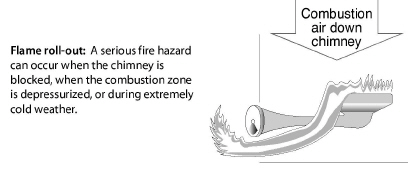
Take all necessary steps to reduce CAZ depressurization and minimize combustion spillage, based on your tests.
Worst-Case CAZ Depressurization Test
Follow the steps below to find the worst-case depressurization level in the combustion appliance zone (CAZ).
1. Close all exterior doors, windows, and fireplace damper(s). Open all interior doors, including closet doors.
2. Remove furnace filter if it’s dirty. Leave the dirty filter out for the test or replace it with a new filter. Be sure the filter slot is covered for the test.
3. Record the baseline pressure of the CAZ with reference to outdoors.
4. Turn on the clothes dryer and exhaust fans. (Clean clothes dryer filter trap)
5. Open doors to negative zones (rooms with exhaust fans) and close doors to positive zones (bedrooms without returns). Use smoke or a manometer to test room pressures if necessary.
6. Open and close the CAZ door. Record the most negative pressure and note CAZ door position.
7. Turn on the furnace air handler.
8. Open and close the CAZ door. Record the most negative pressure, and note CAZ door position.
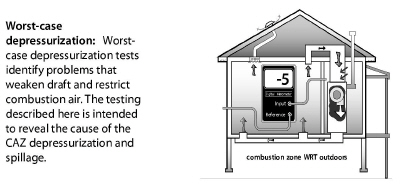
9. Calculate the net difference between the worst depressurization found from either #6 or #8 and the baseline pressure from #3. This is the worst-case depressurization.
10. Refer to the SWS 2.0299.1 Combustion Appliance Depressurization Limits Table or R-values for Common Materials.
11. Specify improvement if the measured worst-case depressurization limit is exceeded. See Mitigating CAZ Depressurization and Spillage
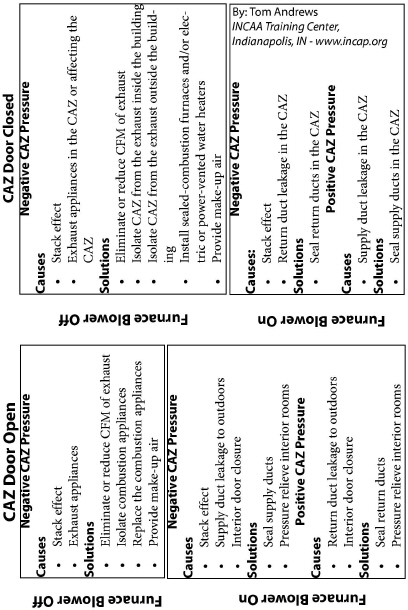
Analyzing CAZ Depressurization
Analyze the negative and positive pressures you measure in the CAZ to find workable solutions, using the troubleshooting table here.

Next, verify that the appliance venting systems don’t spill or produce excessive CO at worst-case depressurization. Test each appliance in turn, starting with the smallest appliance and moving to the largest, for spillage and CO as described below.
1. Check for flue-gas flow in the venting system. Feel the vent connector for heat. The vent connector should start warming within 5 seconds if it establishes flue-gas flow. If the vent connector remains cold, stop the test and investigate.
2. Detect spillage at the draft diverter of each combustion appliance in one of these ways.
a. Smoke from a smoke generator being repelled by spillage at the draft diverter.
b. A mirror fogging at the draft diverter
3. If spillage in one or more appliances continues at worst-case depressurization for 2 minutes or more, take action to correct the problem.
4. Measure CO in the undiluted flue gases of each space heater or water heater after steady-state conditions are reached at worst-case depressurization. If CO in undiluted flue gases is more than 100 ppm as measured or 200 ppm air-free measurement, take action to reduce CO level.
5. Measure CO in the undiluted flue gases of each furnace or boiler after stead-state conditions are reached at worst-case depressurization. If CO in undiluted flue gases is more than 200 ppm as measured or 400 ppm air-free measurement, take action to reduce CO level.
Spillage: Spillage is an indication of whether the combustion gases are exiting the building as they should. In this guide, we focus on spillage because it’s spillage we’re trying to avoid, and we can detect it easily.
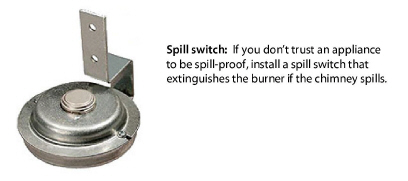
8.2.5 Mitigating CAZ Depressurization and Spillage
|
SWS Detail: 2.0203.1 Combustion Air for Natural Draft Appliances |
If you find problems with CAZ depressurization or spillage, consider the improvements discussed next to solve the problems.
If the appliance spills, open a window, exterior door, or interior door to observe whether the additional combustion airflow through that opening stops the spillage.
1. If this additional air improves draft, the problem is usually depressurization.
2. If this additional air doesn’t stops the spillage, inspect the chimney. The chimney may be obstructed, undersized, oversized, or leaky.
Improvements to Mitigate CAZ Depressurization
This list of improvements may solve spillage problems detected during the previous tests on a forced air heating system.
✓ Seal all return-duct leaks in the CAZ.
✓ Isolate combustion appliances from exhaust fans, clothes dryers, and return registers by air sealing between the CAZ and zones containing these depressurizing devices as described on this location. .
✓ Provide make-up air for dryers and exhaust fans. See this locaiton.
✓ Reduce the CFM of exhaust appliances.
|
Problem |
Possible Solutions |
|---|---|
|
Spills immediately and continuously |
Remove chimney blockage, seal chimney air leaks, or provide additional combustion air as necessary. |
|
Exhaust fans cause spillage |
Provide make-up or combustion air if opening a door or window to outdoors improves draft during testing. |
|
Blower activation causes spillage |
Seal return leaks in the furnace and in nearby return ducts. Isolate the furnace from nearby return registers. |
Chimney Improvements to Mitigate Spillage Problems
Suggest the following chimney improvements to mitigate spillage problems detected during the previous testing.
• Remove chimney obstructions.
• Repair disconnections or leaks at joints and where the vent connector joins a masonry chimney.
• Measure the size of the vent connector and chimney and compare to vent-sizing information listed in Chapter 13 of the National Fuel Gas Code (NFPA 54). A vent connector or chimney liner that is either too large or too small can reduce draft.
• If wind interferes with draft, install a wind-dampening chimney cap.
• If the masonry chimney is deteriorated, install a new chimney liner.
• Increase the pitch of horizontal sections of vent, or more importantly, decrease its length.
• Increase the vertical rise of the vent connector, directly off the appliance vent fitting.
8.2.6 Zone Isolation for Natural-Draft Vented Appliances
An isolated CAZ improves the safety of natural draft vented appliances in some cases. The CAZ is isolated if it receives combustion air only from outdoors or a ventilated intermediate zone. Inspect the CAZ for connections with the home’s main zone and make sure it is isolated.
1. Seal all connections between the isolated CAZ and the home. Examples include joist spaces, transfer grilles, leaky doors, and holes for ducts or pipes.
2. Measure a base pressure from the CAZ to outdoors.
3. Set-up house in worst case, and verify that the set-up doesn’t affect the CAZ pressure.
4. Measure steady-state CO and O2 at worst-case and evaluate combustion air as described in Evaluating Combustion Air.
5. If the CAZ-to-outdoors pressure changed, air-seal the zone, and retest as described in steps 2 and 3.
6. If you can’t air-seal the CAZ adequately to isolate the zone, solve worst-case depressurization and spillage problems as described in Mitigating CAZ Depressurization and Spillage.

8.3 Electronic Combustion Analysis
|
SWS Detail: 5.3003.2 Combustion Analysis of Oil-Fired Appliances, 2.0201.2 Combustion Safety - Make-up Air, 5.3003.14 Combustion Analysis of Gas-Fired Appliances (LP and Natural Gas |
The goal of a combustion analysis is to quickly analyze combustion safety and efficiency. When the combustion appliance reaches steady-state, you can measure its most critical combustion parameters. This information saves time and informs both service and installation adjustments.
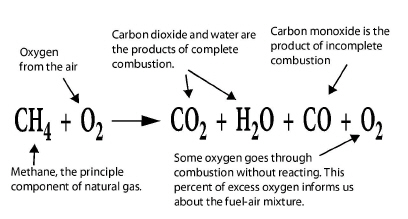
Modern combustion analyzers measure O2, CO, and flue-gas temperature. Some models also measure draft. Combustion analyzers also calculate steady-state efficiency (SSE).
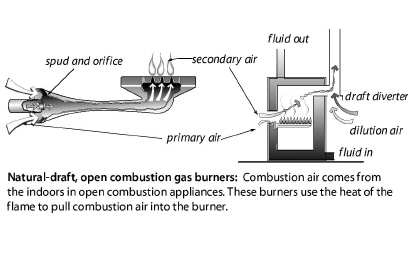
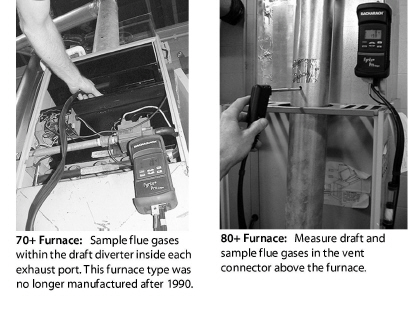
8.3.1 Critical Combustion-Testing Parameters
These furnace-testing parameters tell you how efficient and safe the furnace currently is and how much you might be able to improve efficiency. Use these measurements to analyze the combustion process.
Carbon monoxide (CO) (ppm):
Poisonous gas indicates incomplete combustion. Modern combustion analyzers let you choose between an as-measured value or a calculated value that states the concentration of CO in theoretical air-free flue gases. Adjusting combustion to produce less than 100 ppm as measured or 200 ppm air-free is almost always possible with fuel-pressure adjustments, air adjustments, or burner maintenance.
Oxygen (percent):
Indicates the percent of excess air and whether fuel-air mixture is within a safe and efficient range. Efficiency increases as oxygen decreases because excess air, indicated by the O2 carries heat up the chimney. Percent O2 may also indicate the cause of CO as either too little or too much combustion air. Technicians used to measure CO2, but O2 is easier to measure, and you only need to measure one of these two gases. All electronic combustion analyzers measure O2, but most calculate CO2.
Flue-gas temperature:
Flue-gas temperature is directly related to furnace efficiency. Too high flue-gas temperature wastes energy and too-low flue-gas temperature causes corrosive condensation in the venting system.
Smoke number
For oil only, this measurement compares the stain made by flue gases with a numbered stain-darkness rating called smoke number. Smoke number should be 1 or lighter on a 1-to-10 smoke scale.
Draft
The pressure in the chimney or vent connector (chimney draft or breech draft). Also the pressure in the combustion chamber (over-fire draft), used primarily with oil power burners.
8.4 Heating System Replacement
|
SWS Detail: 2.0702 Installed Equipment, 2.0103.1 Combustion Worker Safety, 5.3101.1 Heat Load Calculation—Whole House |
This section discusses replacing combustion furnaces and boilers. We’ll also discuss gas heating-replacement and oil-heating-replacement specifications.
8.4.1 Combustion Furnace Replacement
This section discusses air handlers of combustion furnaces and also heat pumps. Successful air-handler replacement requires selecting the right heat (and cooling) input, blower model, and blower speed. The installation must include making repairs to ducts and other remaining components, and testing to verify that the new air handler operates correctly.
Preparation
✓ Recover refrigeration in the existing heating-cooling unit according to EPA regulations.
✓ Disconnect and remove the furnace or heat pump, attached air-conditioning equipment, and other materials that won’t be reused.
✓ Transport these materials off the client’s property to a recycling facility.
✓ Verify that all accessible ducts were sealed as part of the furnace’s installation, including the air handler, the plenums, and the branch ducts.
Equipment Selection
✓ Evaluate the building to determine the correct size of the furnace, using ACCA Manual J or equivalent method. Select the smallest BTUH output furnace that your preferred manufacturer offers and that exceeds your heat loss calculation.
✓ Select the air handler using ACCA Manual S or equivalent method along with manufacturers’ air-handler specifications. Consider blower airflow requirements for air conditioning if there is existing central air conditioning.
✓ Select the supply and return registers using ACCA Manual T or equivalent method.
Air-Handler Installation
✓ Install MERV 6 or higher filter inside or outside of the new furnace.
✓ The filter must be easy to replace.
✓ The filter retainer must hold the filter firmly in place.
✓ The filter must provide complete coverage of blower intake or return grille. The filter compartment must not permit air to bypass the filter.
✓ If flue-gas temperature or supply air temperature are unusually high, check static pressure and fuel input. See Ducted Air Distribution
✓ Attach the manufacturer’s literature including, operating manual and service manual, to the furnace.
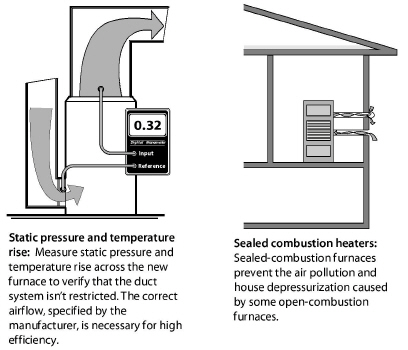
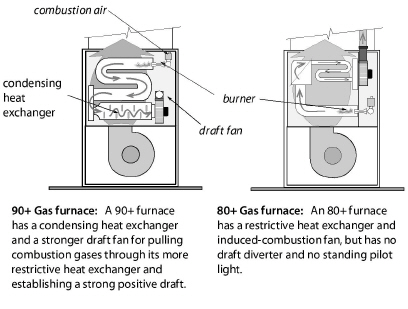
Supporting Air Handlers
Support the new air handlers using these specifications.
• Support horizontal air handlers from below with a non-combustible, water-proof, and non-wicking material. Or support the horizontal air handler with angle iron and threaded rod from above.
• Support upflow air handlers with corner support legs, bricks, or pads from below when necessary to hold it above a damp basement floor.
• Support downflow air handlers with a strong, airtight supply plenum. Insulate this supply plenum on the exterior of the plenum.
8.4.2 Gas-Fired Heating Installation
|
SWS Detail: 2.0201.2 Combustion Safety - Make-up Air, 5.3003.14 Combustion Analysis of Gas-Fired Appliances (LP and Natural Gas), 2.0702 Installed Equipment |
The goals of gas-appliance replacement are to save energy and improve heating safety. The heating replacement project should produce a gas-fired heating system in virtually new condition, even though existing components like the gas lines, chimney, pipes, or wiring may remain.
Include maintenance or repair of existing components as part of the installation. Analyze design defects in the original system, and correct the defects during the heating system’s replacement.
• Install non-condensing furnaces and boilers with a minimum AFUE of 80% if the 90% replacement unit isn’t cost-effective or practical.
• Install new gas-fired unit with adequate clearances to allow maintenance.
• Follow manufacturer’s venting instructions along with the National Fuel Gas Code (NFPA 54) to install a proper venting system. See Inspecting Venting Systems
• Check clearances of the heating unit and its vent connector to nearby combustibles, according to NFPA 54. See this locaiton.
• Measure the new unit’s gas input, and adjust the gas input if necessary.
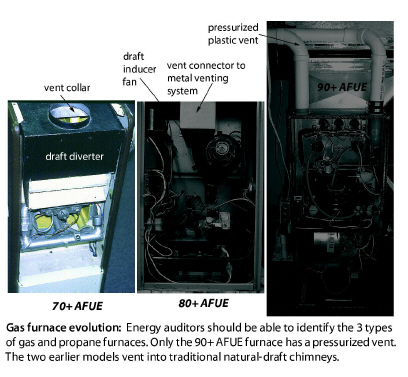
Testing New Gas-Fired Heating Systems
✓ Do a combustion test, and adjust fuel-air mixture to minimize O2. However don’t allow CO beyond 200 ppm as measured or 400 ppm air-free with this adjustment. See this location and this location. Table Table 8-3: .
✓ Verify that the gas water heater vents properly after installation of a sealed-combustion or horizontally vented furnace or boiler. Install a chimney liner if necessary to provide right-sized venting for the water heater.
8.4.3 Combustion Boiler Replacement
|
SWS Details: 2.0103.1 Combustion Worker Safety, 5.3001.1 Load Calculation and Equipment Selection, 5.3101.2 Space Load Calculation—Heat Emitter Sizing,2.0702 Installed Equipment |
Technicians replace boilers as an energy-conservation measure or for health and safety reasons.
Boiler piping and controls present many options for zoning, boiler staging, and energy-saving features. Dividing homes into zones, with separate thermostats, can significantly improve energy efficiency compared to operating a single zone.
Follow these specifications when recommending a replacement boiler.
Design
A boiler’s seasonal efficiency is more sensitive to correct sizing than is a furnace’s efficiency.
✓ Determine the correct size of the boiler, using ACCA Manual J and considering the installed radiation surface connected to the boiler.
✓ Consider weatherization work that reduced the heating load serviced by the previous boiler when sizing the new boiler.
✓ Size new radiators according to room heat loss and design water temperature.
✓ Specify radiator temperature controls (RTCs) for areas with a history of overheating.
✓ A functioning pressure-relief valve, expansion tank, air-excluding device, back-flow preventer, and an automatic fill valve must be part of the new hydronic system.

Pump and Piping
✓ Verify that all supply-pipe insulation is inspected and replaced according to manufacturer’s specifications.
✓ Suggest that the pump be installed near the downstream side of the expansion tank to prevent the suction side of the pump from depressurizing the piping, which can pull air into the piping system.
✓ Replace the expansion tank, unless it’s the proper size for the new system. Adjust the expansion tank for the correct pressure during boiler installation. See this locaiton.
✓ Extend new piping and radiators to conditioned areas, like additions and finished basements, which are currently heated by space heaters.
Controls
✓ Maintaining a low-limit boiler-water temperature is wasteful. Boilers should be controlled for a cold start, unless the boiler is used for domestic water heating.
✓ For large boilers, install reset controllers that adjust supply water temperature according to outdoor temperature and prevent the boiler from firing when the outdoor temperature is above a setpoint where heat isn’t needed.
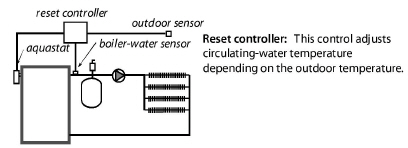
✓ Verify that return-water temperature is above 130° F for gas and above 150° F for oil, to prevent acidic condensation within the boiler, unless the boiler is designed for condensation. Install piping bypasses, mixing valves, primary-secondary piping, or other strategies, as necessary, to prevent condensation within a non-condensing boiler.
Combustion Testing
✓ Inspect the chimney and upgrade it if necessary.
✓ Verify that flue-gas oxygen and temperature are within the ranges specified in these two tables.
a. Combustion Standards for Gas Furnaces and Boilers
b. Minimum Oil Burner Combustion Standards
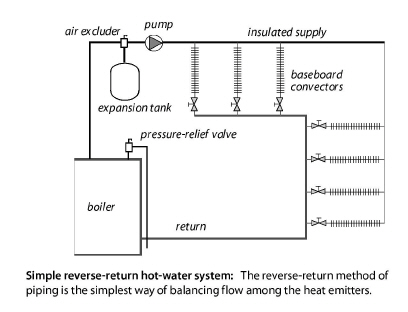
Steam Boilers
Steam-boiler performance is heavily dependent on the performance of the existing steam distribution system. The boiler installer should know how the distribution system performed when it was connected to the old boiler.
The new boiler’s water line should be at the same height as the old boiler’s water line, or the installers should know how to compensate for the difference in water-line levels. See Steam Heating and Distribution
8.4.4 Oil-Fired Heating Installation
Oil-heating replacement should provide an oil-fired heating system in virtually new condition, even though components like the oil tank, chimney, piping, and wiring may remain in place.
Any maintenance or repair for these remaining components should be part of the replacement job and performed by a licensed heating contractor. The contractor should also analyze design defects of the original system, and correct them during the heating-system replacement.
✓ New oil-fired furnaces and boilers should have a minimum AFUE of 83%. See Energy Star Website
✓ Install new oil-fired furnaces and boilers with adequate clearances to facilitate maintenance.
✓ Inspect the existing chimney and the vent connector. Re-place the vent connector with Type L double-wall vent pipe if necessary.
✓ Install a stainless steel chimney liner if necessary. See Special Venting Considerations for Gas
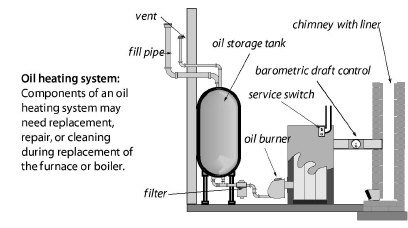
✓ Verify that the clearances between the vent connector and nearby combustibles are adequate. See Clearances to Combustibles for Vent Connectors.
✓ Install a new fuel filter, and purge the fuel lines as part of the new installation.
Controls
✓ Verify that a working emergency shut-off is installed in the living space.
✓ Look for a control that interrupts power to the burner in the event of a fire.
✓ Measure the transformer voltage to verify that it complies with the manufacturer’s specifications.
✓ Measure the control circuit amperage, and adjust the thermostat’s heat anticipator to match the amperage. Or, follow the thermostat manufacturer’s instructions for adjusting cycle length.
Testing New Oil-Fired Heating Systems
✓ Verify that the oil pressure matches the manufacturer’s specifications, but isn’t less than 100 psi.
✓ If the flue-gas temperature is too high, adjust oil pressure per manufacturers instructions or replace nozzle as necessary to produce the correct input and flue-gas temperature.
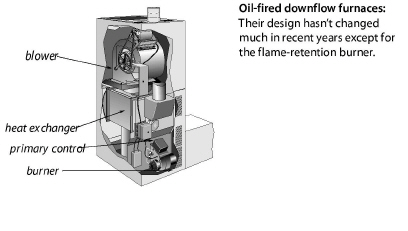
✓ Verify that the spray angle and spray pattern fit the size and shape of the combustion chamber.
✓ Adjust oxygen, flue-gas temperature, and smoke number to match manufacturer’s specifications or specifications given here. Smoke number should be zero on all modern oil-fired equipment.
Inspect the oil tank, and remove dirt and moisture at bottom of the tank. Verify that the oil tank and oil lines comply with NFPA 31.
Oil tanks are now almost always installed above ground. But many old oil tanks are still buried. Inspect above-ground tanks for leaks, heavy rust, or presence of “stalactites” on the bottom of the tank. Contact DES Safe Tank program for tanks in immediate danger of leakage.
See also NFPA 31 Chapter 7 Fuel Oil Tanks.
Inspecting Above-Ground Oil Tanks
Indoor oil leaks are usually accompanied by petroleum smells. Inspect the oil tank as well as all the oil piping between the oil tank and the oil-fired furnace.
✓ Look for different colors on the tank from condensation, corrosion, or fuel leaks.
✓ Look at the bottom of the oil tank and see if oil is dripping from a leak.
✓ Look for patches from previous leaks.
✓ If the oil tank is new, don’t mistake previous oil-tank leaks for leaks in the new tank.
✓ Use the water test described previously.
Advice for Below-Ground Oil Tanks
Leaky below-ground oil tanks are a financial problem and a major environmental problem. Contact DES Safe Tank program if a below-ground tank is present.
8.5 Combustion Space Heater Replacement
|
SWS Detail: 2.0201.2 Combustion Safety - Make-up Air, 2.0103.1 Combustion Worker Safety |
Space heaters are inherently more efficient than central heaters, because they have no ducts or distribution pipes.
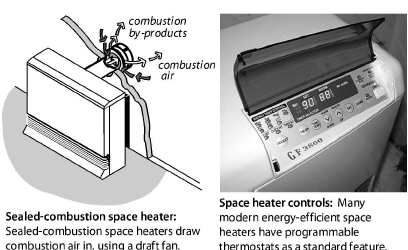
Weatherization agencies replace space heaters as an energy-conservation measure or for health and safety reasons. Choose a sealed-combustion space heater. Inspect existing space heaters for health and safety problems.
✓ If power outages are common, select a space heater that will work without electricity.
✓ Follow manufacturer’s venting instructions carefully. Don’t vent sealed-combustion or mechanically drafted space heaters into naturally drafting chimneys.
✓ At the outside termination verify that flue-gas oxygen and temperature are within the ranges specified in Table Table 8-3: .
✓ If the space heater sits on a carpeted floor, install a fire-rated floor protector.
✓ Install the space heater away from traffic, draperies, and furniture.
✓ Provide the space heater with a correctly grounded duplex receptacle for its electrical service.
Inform the client of the following operating instructions.
✓ Don’t store any objects near the space heater that would restrict airflow around it.
✓ Don’t use the space heater to dry clothes or for any purpose other than heating the home.
✓ Don’t allow anyone to lean or sit on the space heater.
✓ Don’t spray aerosols near the space heater. Many aerosols are flammable or can cause corrosion to the space heater’s heat exchanger.
|
SWS Detail: 2.0202.1 Unvented Space Heaters: Propane, Natural Gas, and Kerosene Heaters, 2.0401.1 Air Sealing Moisture Precautions |
Unvented space heaters include ventless gas fireplaces and gas logs installed in fireplaces previously designed for wood-burning or coal-burning. These unvented space heaters create indoor air pollution because they deliver all their combustion byproducts to the indoors. Unvented space heaters aren’t safe. Replace them with vented space heaters or electric space heaters.
DOE forbids unvented space heaters as primary heating units in weatherized homes. However, unvented space heaters may be used as secondary heaters, under these five requirements.
1. The heater must have an input rating less than 40,000 BTUH.
2. If located in a bedroom, the heater must have an input rating of less than 10,000 BTUH.
3. If located in a bathroom, the heater must have an input rating of less than 6,000 BTUH and adequate combustion and ventilation air must be provided.
4. The heater must be equipped with an oxygen-depletion sensor.
5. The room containing the heater must have adequate combustion air.
6. Home must have adequate ventilation, when approved by the authority having jurisdiction: See ASHRAE Standard 62.2–2016 Ventilation
8.6 Gas Burner Safety & Efficiency Service
Gas burners should be inspected and maintained during a service call. These following specifications apply to gas furnaces, boilers, water heaters, and space heaters.
8.6.1 Combustion Efficiency Test for Furnaces
Perform the following procedures at steady-state to verify a furnace’s correct operation.
• Perform a combustion test using a electronic flue-gas analyzer. Recommended flue-gas temperature depends on the type of furnace and is listed in the table titled, Combustion Standards for Gas Furnaces and Boilers.
• Measure temperature rise (supply minus return temperatures). Temperature rise should be within the manufacturer’s specifications for a furnace: usually between 30° and 70°.
• If O2 is high, or the estimated output from the table is low, increase gas pressure until you measure 6% O2 if possible, as long as you don’t create CO in the process.
• Increase gas pressure if needed to increase temperature rise and flue-gas temperature. This is done by a heating technician.

8.6.2 Inspecting Gas Combustion Equipment
Perform the following inspection procedures on all gas-fired furnaces, boilers, water heaters, and space heaters, as necessary.
✓ Look for soot, melted wire insulation, and rust in the burner and manifold inside and outside the burner compartment. These signs indicate flame roll-out, combustion gas spillage, CO, and incomplete combustion.
✓ Inspect the burners for dust, debris, misalignment, flame-impingement, and other flame-interference problems. Call for CTE if present.
✓ Inspect the heat exchanger for cracks, holes, or leaks.
✓ Verify that furnaces and boilers have dedicated circuits with safety shutoffs near the appliance. Verify that all 120-volt wiring connections are enclosed in covered electrical boxes.
✓ Check venting system for proper diameter and pitch. See this locaiton.
✓ Check venting system for obstructions, blockages, or leaks.
✓ Observe flame characteristics if possible. Flames should be blue and well shaped. If flames are white or yellow, the burner may suffer from faulty combustion.
The goal of these measures is to reduce carbon monoxide (CO), stabilize flame, and verify the operation of safety controls. Any adjustments should be performed by qualified personnel.
✓ Do an electronic combustion analysis and note the oxygen, CO, and flue-gas temperature.
✓ Test for spillage or a heating technician should measure draft. Take action to improve the draft if it is inadequate because of improper venting, obstructed chimney, leaky chimney, or depressurization. See this locaiton.
✓ If you measure CO and the measured oxygen level is low, open a window while observing CO level on the meter to see if CO is reduced by increasing the available combustion air through the open window. See this locaiton.
✓ Adjust gas input if combustion testing indicates over-firing or under-firing.
Burner Cleaning
The auditor should call for a CTE if any of these conditions exist.
• CO is greater than 100 ppm as measured or 200 ppm air-free measurement for space heaters and water heaters and 200 ppm as measured or 400 air-free for furnaces or boilers.
• Visual indicators of soot or flame roll-out exist.
• Burners are visibly dirty.
• If the measured draft that was taken by the heating technician is inadequate. See this locaiton.
• The appliance has not been serviced for two years or more.
Maintenance and Cleaning
Gas-burner and gas-venting maintenance should include the following measures.
✓ Remove causes of CO and soot, such as over-firing, closed primary air intake, flame impingement, and lack of combustion air.
✓ Remove dirt, rust, and other debris that may be interfering with the burners. Clean the heat exchanger if there are signs of soot around the burner compartment.
✓ Seal leaks in vent connectors and chimneys. Make sure the chimney clean-out door fits tightly.
8.7 Oil Burner Safety and Efficiency Service
Oil burners require annual maintenance to maintain acceptable safety and combustion efficiency. Use combustion analysis to evaluate the oil burner and to guide maintenance and adjustment. These procedures apply to oil-fired furnaces, boilers, and water heaters. Use other test equipment as discussed to measure other essential operating parameters and to make adjustments as necessary.
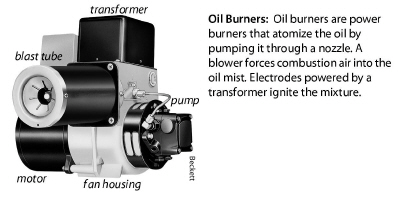
8.7.1 Oil Burner Testing and Adjustment
|
SWS Detail: 5.3003.2 Combustion Analysis of Oil-Fired Appliances |
Unless the oil-fired heating unit is very dirty or disabled, heating technicians should do combustion testing and adjust the burner for safe and efficient operation.
Combustion Testing and Adjustment
Combustion testing is essential to understanding the current oil burner performance and potential for improvement.
✓ Sample the undiluted flue gases with a smoke tester, after reading the smoke tester instructions. Compare the smoke smudge left by the gases on the filter paper with the manufacturer’s smoke-spot scale to find the smoke number.
✓ If the smoke number is higher than 2, take steps to reduce smoke before sampling the gases with a combustion analyzer to prevent the smoke from fouling the analyzer.
✓ Sample undiluted flue gases between the barometric draft control and the appliance. Analyze the flue gas for O2, flue-gas temperature, CO, and steady-state efficiency (SSE).
✓ Measure the overfire draft over the fire inside the firebox through a plug in the heating unit.
✓ Adjust the barometric damper for a negative overfire draft of–0.020 IWC or –5 pascals at a test plug in the heating unit.
✓ Adjust the air shutter to achieve the oxygen and smoke values, specified in Table Table 8-5: .
✓ Adjust oxygen, flue-gas temperature, CO, and smoke number to match manufacturer’s specifications or specifications given here. Smoke number should be near zero on all modern oil-fired equipment.
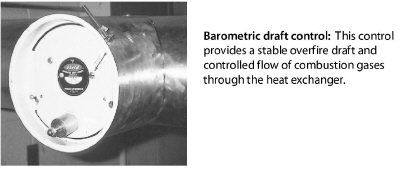
Other Efficiency Testing and Adjustment
The following steps should be performed by a heating technician.
✓ Adjust the gap between electrodes and their angle for proper alignment.
✓ Measure the control-circuit amperage. Adjust the thermostat’s heat anticipator to match the amperage, or read the thermostat manufacturer’s instructions for adjusting cycle length.
✓ Measure the oil-pump pressure, and adjust it to manufacturer’s specifications if necessary.
✓ Measure the transformer voltage, and adjust it to manufacturer’s specifications if necessary.
✓ Adjust the airflow or the water flow to reduce high flue-gas temperature if possible, but don’t reduce flue-gas temperature below 350°F.
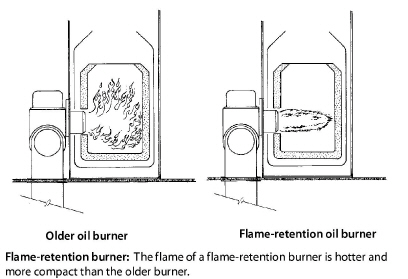
8.7.2 Oil Burner Inspection and Maintenance
Use visual inspection and combustion testing to evaluate oil burner operation. An oil burner that passes visual inspection and complies with the specifications on this location. may need no maintenance. Persistent unsatisfactory test results may indicate the need to replace the burner or the entire oil-fired heating unit.
Safety Inspection, Testing, and Adjustment
✓ Inspect burner and appliance for signs of soot, overheating, fire hazards, corrosion, or wiring problems.
✓ Inspect heat exchanger and combustion chamber for cracks, corrosion, or soot buildup, to the extent possible.
✓ If the unit smells excessively of oil, test for oil leaks and repair the leaks.
✓ Time the flame sensor control or stack control to verify that the burner shuts off, within either 45 seconds or a time specified by the manufacturer, when the cad cell is blocked from seeing the flame. This step should be performed by a heating technician.
✓ Measure the high limit shut-off temperature and adjust or replace the high limit control if the shut-off temperature is more than 200° F for furnaces, or 220° F for hot-water boilers. This step should be performed by a heating technician.
Oil Burner Maintenance
After evaluating the oil burner’s operation, specify some or all of these maintenance tasks as necessary, to optimize safety and efficiency.
✓ Clean the burner’s blower wheel.
✓ Clean dust, dirt, and grease from the burner assembly.
✓ Replace oil filter(s) and nozzle.
✓ Clean or replace air filter.
✓ Remove soot from combustion chamber.
✓ Remove soot from heat exchange surfaces.
✓ Adjust gap between electrodes to manufacturer’s specs.
✓ Check if the nozzle and the fire ring of the flame-retention burner is appropriate for the size of the combustion chamber.
✓ Repair the ceramic combustion chamber, or replace it if necessary.
✓ Verify correct flame sensor operation.
After these maintenance procedures, the technician carries out the diagnostic tests described previously to evaluate improvement made by the maintenance procedures and to determine whether more adjustment or maintenance is required.
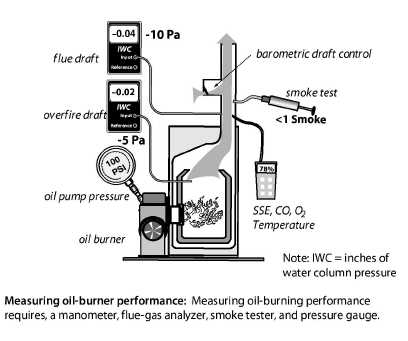
Wood heating is a popular and effective auxiliary heating source for homes. However, wood stoves and fireplaces can cause indoor air pollution and fire hazards. Inspect wood stoves to evaluate potential hazards.
Stoves that are listed by a testing agency like Underwriters Laboratory have installation instructions stating their clearance from combustibles. Unlisted stoves must adhere to clearances specified in NFPA 211.
Look for metal tags on the wood stove that list minimum clearances. Listed wood stoves may be installed to as little as 6 inches away from combustibles, if they incorporate heat shields and combustion design that directs heat away from the stove’s back and sides.
Unlisted stoves must be at least 36 inches away from combustibles. Ventilated or insulated wall protectors may decrease unlisted clearance from one-third to two thirds, according to NFPA 211. Always follow the stove manufacturer’s or heat-shield manufacturer’s installation instructions.
Floor Construction and Clearances
The floor of a listed wood stove must comply with the specifications on the listing (metal tag). Modern listed stoves usually sit on a 1-inch thick non-combustible floor protector that extends 18 inches beyond the stove in front.
The floor requirements for underneath a unlisted wood stove depends on the clearance between the stove and the floor, which depends on the length of its legs. Unlisted wood stoves must have floor protection underneath them unless they rest on a floor of non-combustible construction. An example of a noncombustible floor is one composed of only masonry material sitting on sand or gravel.
An approved floor protector is either one or two courses of hollow masonry material (4 inches thick) with a non-combustible quarter-inch surface of steel or other non-combustible material on top of the masonry. This floor for a non-listed wood stove must extend no less than 18 inches beyond the stove in all directions.
Vent-Connector and Chimney Clearance
Interior masonry chimneys require a 2-inch clearance from combustibles and exterior masonry chimneys require a 1-inch clearance from combustibles. All-fuel metal chimneys (insulated double-wall or triple wall) usually require a 2- inch clearance from combustibles.
Double-wall stove-pipe vent connectors require a 9-inch clearance from combustibles or a clearance listed on the product. Single wall vent connectors must be at least 18 inches from combustibles. Wall protectors may reduce this clearance up to two-thirds.
See also Wood Stove Clearances and Stove Clearances.
All components of wood stove venting systems should be approved for use with wood stoves. Chimney sections penetrating floor, ceiling, or roof should have approved thimbles, support packages, and ventilated shields to protect nearby combustible materials from high temperatures. Perform or specify the following inspection tasks.
✓ Inspect stove, vent connector, and chimney for correct clearances from combustible materials as listed on stoves and vent assemblies or as specified in NFPA 211.
✓ Each wood stove must have its own dedicated flue pipe. Two wood stoves may not share a single flue.
✓ If the home is tight (<0.35 ACH), the wood stove should be equipped with a dedicated outdoor combustion-air duct.
✓ Inspect vent connector and chimney for leaks. Leaks should be sealed with a high temperature sealant designed for sealing wood stove vents.
✓ Galvanized-steel pipe must not be used to vent wood stoves.
✓ Inspect chimney and vent connector for creosote build-up, and suggest chimney cleaning if creosote build-up exists.
✓ Inspect the house for soot on seldom-cleaned horizontal surfaces. If soot is present, inspect the wood stove door gasket. Seal stove air leaks or chimney air leaks with stove cement. Improve draft by extending the chimney to reduce indoor smoke emissions.
✓ Inspect stack damper and/or combustion air intake damper.
✓ Check catalytic converter for repair or replacement if the wood stove has one.
✓ Assure that heat exchange surfaces and flue passages within the wood stove are free of accumulations of soot or debris.
✓ Wood stoves installed in manufactured homes must be approved for use in manufactured homes.

8.9 Inspecting Venting Systems
Combustion gases are vented through vertical chimneys or other types of approved horizontal or vertical vent piping. Identifying the type of existing venting material, verifying the correct size of vent piping, and making sure the venting conforms to the applicable codes are important tasks in inspecting and repairing venting systems. Too large a vent often leads to condensation and corrosion. Too small a vent can result in spillage. The wrong vent materials can corrode or deteriorate from heat.
The National Fire Protection Association (NFPA) publishes authoritative information on material-choice, sizing, and clearances for chimneys and vent connectors, as well as for combustion air. The information in this venting section is based on the following NFPA documents.
• NFPA 54: The National Fuel Gas Code
• NFPA 31: Standard for the Installation of Oil-Burning Equipment
• NFPA 211: Standard for Chimneys, Fireplaces, Vents, and Solid-Fuel-Burning Appliances
A vent connector connects the appliance’s venting outlet collar with the chimney. Approved vent connectors for gas-fired units are made from the following materials.
• Type-B vent, consisting of a galvanized steel outer pipe and aluminum inner pipe for gas-fired units.
• Type-L vent connector with a stainless-steel inner pipe and a galvanized-steel outer pipe for oil-fired units.
• Double-wall stove-pipe vent connector with a stainless-steel inner pipe and a black-steel outer pipe for solid-fuel units.
• Galvanized steel pipe for gas or oil-fired units only: See table.
|
Inches (gauge) |
|
|---|---|
|
5 and smaller |
0.022 (26 gauge) |
|
6 to 10 |
0.028 (24 gauge) |
|
11 to 16 |
0.034 (22 gauge) |
|
Larger than 16 |
0.064 (16 gauge) |
|
From International Mechanical Code 2009 |
|
Double-wall vent connectors are the best option, especially for appliances with some non-vertical vent piping. A double-wall vent connector maintains flue gas temperature and prevents condensation. Gas appliances with draft hoods, installed in attics or crawl spaces must use a Type-B vent connector. Use Type-L double-wall vent pipe for oil vent connectors in attics and crawl spaces.
Vent-Connector Requirements
Verify that vent connectors comply with these specifications.
• Vent connectors must be as large as the vent collar on the appliances they vent.
• Single wall vent-pipe sections must be fastened together with 3 screws or rivets.
• Vent connectors must be sealed tightly where they enter masonry chimneys.
• Vent connectors must be free of rust, corrosion, and holes.
• Maintain minimum clearances between vent connectors and combustibles.
• The chimney combining two draft-hood vent connectors must have a cross-sectional area equal to the area of the larger vent connector plus half the area of the smaller vent connector. This common vent must be no larger than 7 times the area of the smallest vent connector. For specific vent sizes, see the NFPA codes listed on here.
|
Vent diameter |
4" |
5" |
6" |
7" |
8" |
|
Vent area (square inches) |
12.6 |
19.6 |
28.3 |
38.5 |
50.2 |
• The horizontal length of vent connectors shouldn’t be more than 75% of the chimney’s vertical height or have more than 18 inches horizontal run per inch of vent diameter.
• Vent connectors must have upward slope to their connection with the chimney. NFPA 54 requires a slope of at least 1/4-inch of rise per foot of horizontal run so that combustion gases rise through the vent. The slope also prevents condensation from collecting in the vent and corroding it.
|
Diam (in) |
3" |
4" |
5" |
6" |
7" |
8" |
9" |
10" |
12" |
14" |
|
Length (ft) |
4.5' |
6' |
7.5' |
9' |
10.5' |
12' |
13.5' |
15' |
18' |
21' |
|
From International Fuel Gas Code 2000 |
||||||||||
• When two vent connectors connect to a single chimney, the vent connector servicing the smaller appliance must enter the chimney above the vent for the larger appliance.
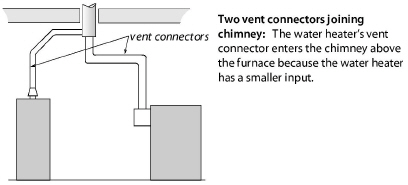
There are two common types of vertical chimneys for venting combustion fuels that satisfy NFPA and ICC codes. First there are masonry chimneys lined with fire-clay tile, and second there are manufactured metal chimneys, including all-fuel metal chimneys, Type-B vent chimneys for gas appliances, and Type L chimneys for oil appliances.
|
SWS Detail: 2.0203.2 Combustion Flue Gas—Orphaned Water Heaters |
Verify the following general specifications for building, inspecting, and repairing masonry chimneys.
• A masonry foundation should support every masonry chimney.
• Existing masonry chimneys should be lined with a fireclay flue liner. There should be a 1/2-inch to 1-inch air gap between the clay liner and the chimney’s masonry to insulate the liner. The liner shouldn’t be bonded structurally to the outer masonry because the liner needs to expand and contract independently of the chimney’s masonry structure. The clay liner can be sealed to the chimney cap with a flexible high-temperature sealant.
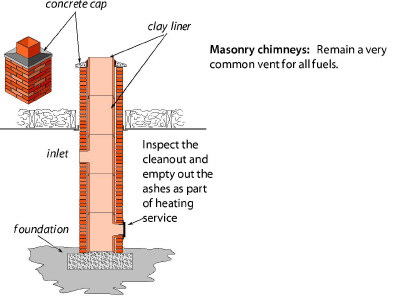
• Masonry chimneys should have a cleanout 12 inches or more below the lowest inlet. Clean mortar and brick dust out of the bottom of the chimney through the clean-out door, so that this debris won’t eventually interfere with venting.
• Seal the chimney’s penetrations through floors and ceilings with sheet metal and high-temperature sealant as a fire-stop and air barrier.
• Re-build deteriorated or unlined masonry chimneys as specified above or reline them as part of a heating-system replacement or a venting-safety upgrade. Or, install a new metal chimney instead of repairing the existing masonry chimney.
Metal Liners for Masonry Chimneys
Install or replace liners in unlined masonry chimneys or chimneys with deteriorated liners as part of heating system replacement. Orphaned water heaters may also need a chimney liner because the existing chimney may be too large. Use a correctly sized Type-B vent, a flexible or rigid stainless-steel liner, or a flexible aluminum liner.

Flexible liners require careful installation to avoid a low spot at the bottom, where the liner turns a right angle to pass through the wall of the chimney. Comply with the manufacturer’s instructions, which usually require stretching the liner and fastening it securely at both ends, to prevent the liner from sagging and creating a low spot.
Flexible liners are easily damaged by falling masonry debris inside a deteriorating chimney. Use B-vent, L-vent, or single-wall stainless steel pipe instead of a flexible liner when the chimney is significantly deteriorated.
To minimize condensation, insulate the flexible liner — especially when installed in exterior chimneys. Consider fiberglass-insulation jackets or perlite, if the manufacturer’s instructions allow. Wood-stove chimney liners must be stainless steel and insulated.
Sizing flexible chimney liners correctly is very important. Oversizing is common and can lead to condensation and corrosion. The manufacturers of the liners include vent-sizing tables in their specifications. Liners should display a label from a testing lab like Underwriters Laboratories (UL).
Masonry chimneys as structural hazards: A building owner may want to consider reinforcing a deteriorated chimney by re-pointing masonry joints or parging the surface with reinforced plaster. Other options include demolishing the chimney or filling it with concrete to prevent it from damaging the building by collapsing during an earthquake.
Solutions for Failed Chimneys
Sometimes a chimney is too deteriorated to be re-lined or repaired. In this case, abandon the old chimney, and install one of the following.
• A double-wall horizontal sidewall vent, equipped with a barometric draft control and a power venter mounted on the exterior wall. Maintain a 4-foot clearance between the ground and the vent’s termination if you live where it snows.
• A new heating unit, equipped with a power burner or draft inducer, that is designed for horizontal or vertical venting.
• A new manufactured metal venting system.
Manufactured metal chimneys have engineered parts that fit together in a prescribed way. Parts include: metal pipe, weight-supporting hardware, insulation shields, roof jacks, and chimney caps. One manufacturer’s chimney may not be compatible with another’s connecting fittings.
All-fuel chimneys (also called Class A chimneys) are used primarily for the solid fuels: wood and coal. All-fuel metal chimneys come in two types: insulated double-wall metal pipe and triple-wall metal pipe. Comply with the manufacturer’s specifications when you install these chimneys.
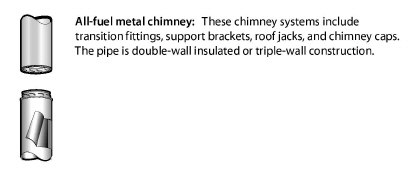
Type-B vent double-wall pipe is permitted as a chimney for gas appliances. Type BW pipe is manufactured for gas space heaters in an oval shape to fit inside wall cavities.
Type L double-wall pipe is used for oil chimneys.
Masonry chimneys and all-fuel metal chimneys should terminate at least three feet above the roof penetration and two feet above any obstacle within ten feet of the chimney outlet.
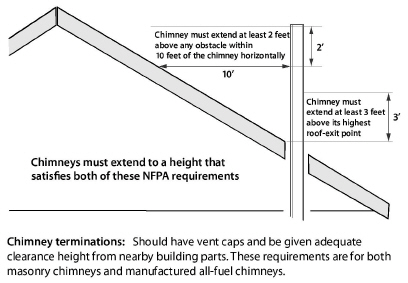
B-vent chimneys can terminate as close as one foot above flat roofs and above pitched roofs up to a 6/12 roof pitch. As the pitch rises, the minimum required termination height, as measured from the high part of the roof slope, rises as shown in this table.
|
flat- 6/12 |
6/12- 7/12 |
7/12- 8/12 |
8/12- 9/12 |
9/12- 10/12 |
10/12- 11/12 |
11/12- 12/12 |
12/12- 14/12 |
14/12- 16/12 |
16/12- 18/12 |
|
1' |
1' 3" |
1' 6" |
2' |
2' 6" |
3' 3" |
4' |
5’ |
6' |
7' |
|
From National Fuel Gas Code 2009 |
|||||||||
8.10.4 Air Leakage through Masonry Chimneys
|
SWS Detail: 4.1001.3 Fireplace Chimney and Combustion Flue Vents |
The existing fireplace damper or “airtight” doors seldom provide a good air seal. Help the client decide whether the fireplace will be used in the future or whether it can be taken out of service. Consider these solutions for chimneys with ineffective or missing dampers.
• Install an inflatable chimney seal along with a notice of its installation to alert anyone wanting to start a fire to remove the seal first.
• Install an operable chimney-top damper and leave instructions on how to open and close it. Also notify users of which position is open and which is closed.
• Air seal the chimney top from the roof with a watertight, airtight seal. Also seal the chimney from the living space with foam board and drywall. If you install a permanent chimney seal such as this, post a notice at the fireplace saying that it is permanently disabled.
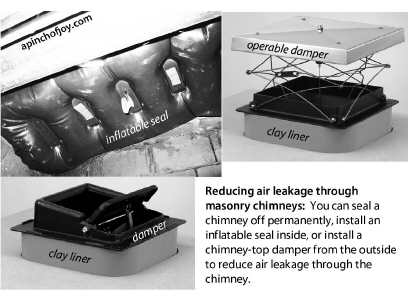
8.11 Special Venting Considerations for Gas
The American Gas Association (AGA) publishes a classification system for venting systems attached to natural-gas and propane appliances. This classification system assigns Roman numerals to four categories of venting based on whether there is positive or negative pressure in the vent and whether condensation is likely to occur in the vent.
.
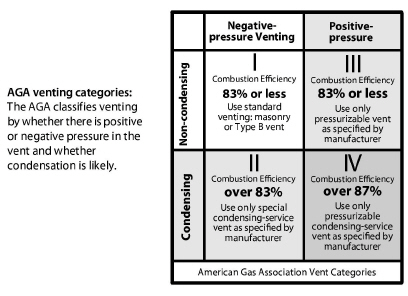
A majority of gas appliances found in homes and multifamily buildings are Category I, which have negative pressure in their vertical chimneys. We expect no condensation in the vent connector or chimney of a Category I appliance.
Condensing furnaces are usually Category IV, have positive pressure in their vent, and condensation occurring in both the appliance and vent. Some fan-assisted water heaters, furnaces, and boilers vent their flue gases through airtight positive-pressure Category III vents, which are supplied by the appliance manufacturer. Category II vents are very rare and beyond the scope of this discussion.
8.11.1 Venting Category I Fan-Assisted Furnaces and Boilers
Newer gas-fired fan-assisted central furnaces and boilers eliminate dilution air and may have slightly cooler flue gases compared to their predecessors. The chimney may experience more condensation than in the past. Inspect the existing chimney to verify that it’s in good condition when considering replacing an old natural-draft unit. Reline the chimney when you see any of these conditions.
• When the existing masonry chimney is unlined.
• When the old clay or metal chimney liner is deteriorated.
• When the new furnace has a smaller input (BTUH) than the old one, the liner should be sized to the new furnace and the existing water heater.
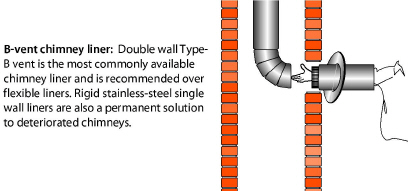
Liner Materials for 80+ Furnaces
For gas-fired 80+ AFUE furnaces, a chimney liner should consist of one of these four materials.
1. A type-B vent
2. A rigid or flexible stainless steel liner (preferably insulated)
3. A poured masonry liner
4. An insulated flexible aluminum liner
Chimney relining is expensive. Therefore consider a power-vented sealed-combustion unit when an existing chimney is inadequate for a new fan-assisted appliance.
8.11.2 Venting Sealed-Combustion Furnaces and Boilers
Some space heaters, furnaces, and boilers use factory-built metal chimneys with single stainless steel liners that vent horizontally under positive pressure.
Condensing furnaces usually employ horizontal or vertical plastic-pipe chimneys.
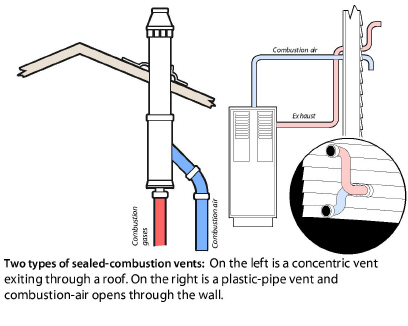
Stainless-steel vents powered by fans in gas and oil appliances exit through walls and don’t require vertical chimneys.
|
Annual Fuel Utilization Efficiency (AFUE) |
Operating characteristics |
|---|---|
|
70+ |
Category I, draft diverter, no draft fan, standing pilot, non-condensing, indoor combustion and dilution air. |
|
80+ |
Category I, no draft diverter, fan-assisted combustion, electronic ignition, indoor combustion air, no dilution air. |
|
80+ |
Category III, horizontal fan-pressurized non-condensing vent, indoor combustion air, no dilution air. |
|
90+ |
Category IV, no draft diverter, fan-pressurized, low-temperature plastic venting, positive draft, electronic ignition, condensing heat exchanger, outdoor combustion air is strongly recommended. |
|
SWS Detail: 2.0203.1 Combustion Air for Natural Draft Appliances |
A combustion appliance zone (CAZ) must contain 50 cubic feet of volume for every 1000 BTUH of appliance input, according to NFPA 54. If all the combustion appliances are sealed-combustion, this regulation doesn’t apply.
For smaller spaces, the NFPA 54 requires additional combustion air from outside the CAZ. Combustion air is supplied to the combustion appliance in four ways.
1. To the CAZ through air leaks in the surrounding building spaces, linked to the CAZ through existing openings.
2. To the CAZ through an intentional opening or openings between the CAZ and surrounding indoor areas where air leaks replenish combustion air.
3. To the CAZ through an intentional opening or openings between the CAZ and outdoors or between the CAZ ventilated intermediate zones like attics and crawl spaces.
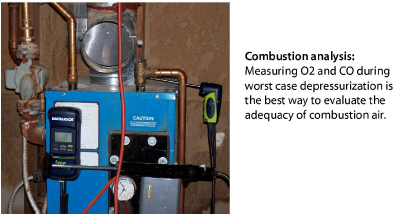
8.12.1 Evaluating Combustion Air
The best way to evaluate the combustion air in an existing building is with an electronic combustion analysis of the building’s combustion appliances. During worst-case testing, the combustion analyzer measures both CO and oxygen (O2). Both O2 and CO are indicators of the adequacy of combustion air.
✓ Sample undiluted flue gases as they leave the appliance’s heat exchanger during worst-case conditions.
✓ If the oxygen reading from the combustion analyzer is more than 5%, this O2 measurement indicates that an adequate amount of combustion air is available.
✓ If the oxygen reading from the combustion analyzer is between 0% and 5%, this indicates that combustion air is inadequate. We would expect to find significant CO with this low 02 reading.
✓ If the 02 is between 0% and 5%, open a nearby window or door a little. If the 02 level rises to an acceptable level, install a combustion air supply from outdoors or from a ventilated intermediate zone.
At 5% or more of flue-gas oxygen, additional indoor or outdoor combustion air is usually unnecessary.
See Worst-Case CAZ Depressurization Testing
8.12.2 Installing Combustion Air
A CAZ must contain more than 50 cubic feet of volume for every 1000 BTUH of appliance input according to NFPA 54.
However, if a small CAZ is connected to adjacent spaces through large air passages like floor-joist spaces, you can count the volume of those spaces.
When the home is relatively airtight (<0.40 ACHn), the CAZ may not have adequate combustion air, even when the CAZ is larger than 50 cubic feet of volume for every 1000 BTUH of appliance input.
Combustion-air vents should be no less than 3 inches in their smallest dimension. A vent with a louver or grille has a net free area (NFA) that is smaller than actual vent area because NFA takes the blocking effect of louvers and grilles into account. Metal grilles and louvers provide about 75% of their area as net-free area while wood louvers provide only about 25%.
Combustion Air from Indoors
When the CAZ is isolated from the surrounded indoor spaces and needs additional combustion air, you can cut holes between indoor spaces to increase combustion air. Of course, spaces that look isolated from each other may already be connected. If two spaces have no pressure difference between them during worst-case conditions, they’re probably already connected.
The National Fuel Gas Code (NFPA 54) presents two methods for calculating combustion air. The simplest of the two methods is discussed in this section.
Here is an example of one indoor space providing combustion air to another indoor space. The furnace and water heater are located in a confined space. The furnace has an input rating of 100,000 BTUH. The water heater has an input rating of 40,000 BTUH. Therefore, there should be 140 in2 of net free area of vent between the mechanical room and other rooms in the home.
([100,000 + 40,000] ÷ 1,000) = 140 x 1 in2 = 140 in2
Each vent should therefore have a minimum of 140 in2 net free area. If a metal grille covers 60% of the opening’s area, divide the 140 in2 by 0.60.
140 in2 / 0.6 = 233 in2
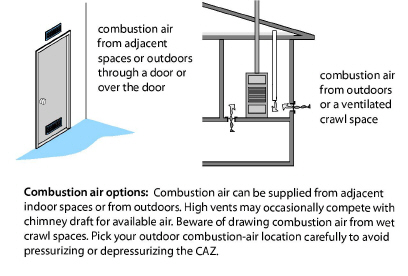
Combustion Air from Outdoors
In tight homes where combustion appliances need outdoor combustion air, install one or two vents to the outdoors using the information in the table Combustion Air Openings: Location and Size.
The choices for outdoor combustion air include the following.
• Connect a pipe between the attic and 8 inches above the floor of the CAZ.
• Connect the CAZ to a ventilated crawl space (if it’s dry)
• Connect the CAZ directly to the outdoors through a single or double vent.
A high combustion air vent into an attic may depressurize the CAZ or deliver warm moist air from the CAZ into a cold attic. Instead, bring a duct from the attic to 8 inches off the floor.
Choose an outdoor location that is sheltered from prevailing winds, but not in an inside corner. Don’t choose an exterior wall that is parallel to prevailing winds. Wind blowing parallel to the exterior wall or at a right angle to the vent opening depressurizes both the vent and the CAZ.
Air Boots for Power Burners
At least one company manufactures a proprietary combustion-air system that introduces outdoor air through an air boot which attaches to a combustion-air duct to outdoors. The most common application is for power oil burners.
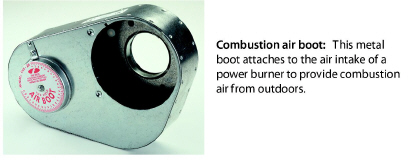
Fan-Powered Combustion Air
At least one company manufactures a proprietary combustion-air system that introduces outdoor air through a fan that sits on the floor and attaches to a combustion-air duct to outdoors, and some large buildings simply use a fan mounted in an otherwise undersized combustion-air opening. 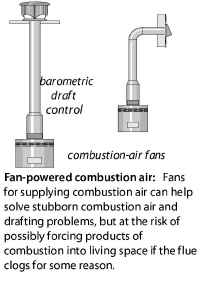
If a fan provides combustion air to open-combustion furnaces and water heaters, the fan should provide 1/3 to 1/2 CFM per 1000 BTUH of forced combustion air.
Pressurizing a mechanical room should be avoided, because it can force products of combustion into the living space. If the fan is too big for the appliances, use a barometric damper on the fan intake to mix room air with incoming outdoor air.
|
SWS Detail: 5.3003.4 Evaluating Electrical Service, 5.3003.11 Heating and Cooling Controls, 5.3003.26 Electrical Service—Mid and High Rise |
The forced-air system consists of an air handler (furnace, heat pump, air conditioner) with its heat exchanger along with attached ducts. The annual system efficiency of forced-air heating and air-conditioning systems depends on the following issues.
• Duct leakage
• System airflow
• Blower operation
• Balance between supply and return air
• Duct insulation levels
The evaluation and improvement of ducts has a logical sequence of steps.
✓ Solve the airflow problems because a contractor might have to replace ducts or install additional ducts.
✓ Determine whether the ducts are located inside the thermal boundary or outside it.
✓ Evaluate the ducts’ air leakage and decide whether duct-sealing is important and if so, find and seal the duct leaks.
✓ If supply ducts are outside the thermal boundary or if condensation is an air-conditioning problem, insulate the ducts.
8.13.2 Solving Airflow Problems
You don’t need test instruments to discover dirty blowers or disconnected branch ducts. Find these problems before measuring duct airflow, troubleshooting the ducts, or sealing the ducts. These steps precede airflow measurements.
1. Ask the client about comfort problems and temperature differences in different rooms of the home.
2. Based on the clients comments, look for disconnected ducts, restricted ducts, and other obvious problems.
3. Inspect the filter(s), blower, and indoor cooling coil for dirt. Clean them if necessary. If the indoor coil isn’t easily visible, a dirty blower means that the coil is probably also dirty.
4. Look for dirty or damaged supply and return grilles that restrict airflow. Clean and repair them.
5. Look for closed registers or closed balancing dampers that could be restricting airflow to uncomfortable rooms.
6. Notice moisture problems like mold and mildew. Moisture sources, like a wet crawl space, can overpower air conditioners by introducing more moisture into the air than the air conditioner can remove.
Measuring Total External Static Pressure (TESP)
The blower creates the duct pressure, which is measured in inches of water column (IWC) or pascals. The return static pressure is negative and the supply static pressure is positive. Total external static pressure (TESP) is the sum of the absolute values of the supply and return static pressures. Absolute value means that you ignore the positive or negative signs when adding supply static pressure and return static pressure to get TESP. This addition represents the distance on a number line as shown in the illustration here.
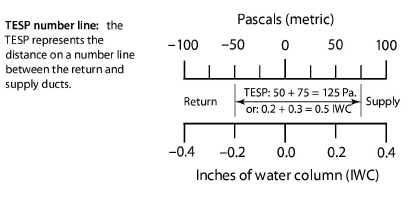
TESP gives a rough indicator of whether airflow is adequate. The greater the TESP, the less the airflow. The supply and return static pressures by themselves can indicate whether the supply or the return or both sides are restricted. For example, if the supply static pressure is 0.10 IWC (25 pascals) and the return static pressure is –0.5 IWC (-125 pascals), you can assume that most of the airflow problems are due to a restricted or undersized return. The TESP gives a rough estimate of airflow if the manufacturer’s graph or table for static pressure versus airflow is available.
1. Attach two static pressure probes to tubes leading to the two ports of the manometer. Attach the high-side port to the probe inserted downstream of the air handler in the supply duct. The other tube goes upstream of the air handler in the return duct. The manometer adds the supply and return static pressures to measure TESP.
2. Consult manufacturer’s literature for a table of TESP versus airflow for the blower or the air handler. Find airflow for the TESP measured in Step 1.
3. Measure pressure on each side of the air handler to obtain both supply and return static pressures separately. This test helps to locate the main problems as related to either the supply or the return.
Static Pressure Guidelines
Air handlers deliver their airflow at TESPs ranging from 0.30 IWC (75 Pascals) to 1.0 IWC (250 Pascals) as found in the field. Manufacturers maximum recommended TESP is usually a maximum 0.50 IWC (125 pascals) for standard air handlers. TESPs greater than 0.50 IWC indicate inadequate airflow in standard residential forced-air systems.
The popularity of pleated filters, electrostatic filters, and high-static high-efficiency evaporator coils, prompted manufacturers to introduce premium air handlers that can deliver adequate airflow at a TESPs of greater than 0.50 IWC (125 pascals). Premium residential air handlers can provide adequate airflow with TESPs of up to 0.90 IWC (225 pascals) because of their more powerful blowers and variable-speed blowers. TESPs greater than 0.90 IWC indicate the possibility of inadequate airflow in these premium residential forced-air systems.
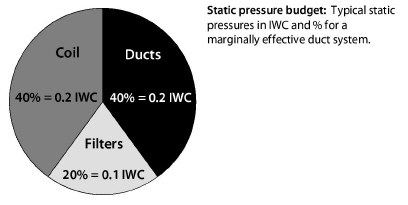
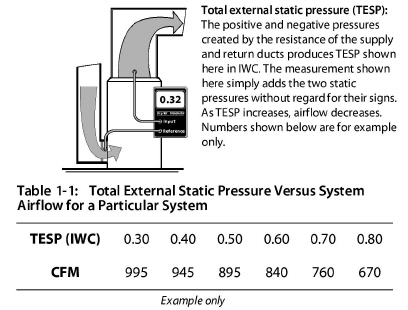

8.13.3 Unbalanced Supply-Return Airflow Test
Closing interior doors often separates supply registers from return grilles in homes with central returns. A bedroom door with no return register and a closed door restricts the bedroom air from returning to the air handler. This restriction pressurizes bedrooms and depressurizes the central areas near return grilles. These pressures can drive air leakage through the building shell, create moisture problems, and bring pollutants in from the crawl space, garage, or CAZ.
The following test uses only the air handler and a digital manometer to evaluate whether the supply air can flow back to the return grilles relatively unobstructed. Activate the air handler and close interior doors.
✓ Measure the pressure difference between the central zone and the bedroom as shown in the next illustration.
✓ To estimate the amount of pressure relief needed, slowly open the bedroom door until the pressure difference drops below 3 pascals.
✓ Estimate the surface area of that door opening. This is the area of the permanent opening required to provide pressure relief. Pressure relief may include undercutting the door or installing transfer grilles or jumper ducts.
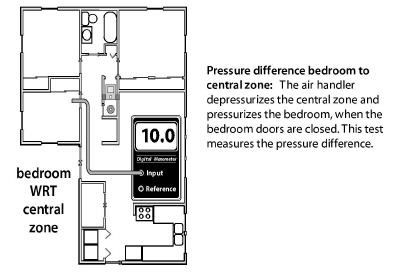


8.13.4 Evaluating Furnace Performance
|
SWS Detail: 5.3003.4 Evaluating Electrical Service, 5.3003.26 Electrical Service—Mid and High Rise |
The effectiveness of a furnace depends on its temperature rise, fan-control temperatures, and flue-gas temperature. For efficiency, you usually want a low temperature rise. However, you must maintain a minimum flue-gas temperature to prevent corrosion in the venting of 70+ and 80+ AFUE furnaces. Apply the following furnace-operation standards to maximize the heating system’s seasonal efficiency and safety.
✓ Perform a combustion analysis as described in Gas Burner Safety & Efficiency Service.
✓ Check temperature rise after at steady-state condition of operation. Refer to manufacturer’s nameplate for acceptable temperature rise (supply temperature minus return temperature). The temperature rise should be within the minimum and maximum temperature rise on the nameplate (usually 40°F and 70°F). Prefer the lower end of this range for energy efficiency.
✓ With temperature-activated controls, verify that the fan-on temperature is 120–140° F.
✓ With time-activated fan controls, verify that the fan is switched on with the shortest time delay available if it is adjustable. The appliance should be switched off with the time delay that achieves a fan off temperature of 20° to 30° above the measured return-air temperature.
✓ Verify that the high limit controller shuts the burner off before the furnace temperature reaches 200°F.
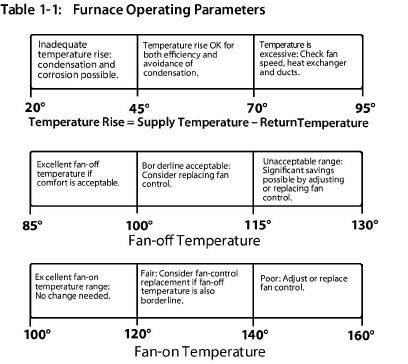
✓ Verify that there is a strong noticeable airflow from all supply registers.
✓ Adjust fan control to conform to these standards, or replace the fan control if adjustment fails. Some fan controls aren’t adjustable.
✓ Adjust the high limit control to conform to the above standards, or replace the high limit control.
✓ All forced-air heating systems must deliver supply air and collect return air only from inside the intentionally heated portion of the house. Taking return air from an un-heated area of the house such as an unconditioned basement or a crawl space isn’t acceptable.

8.13.5 Improving Forced-Air System Airflow
Inadequate airflow is a common cause of comfort complaints. When the air handler is on there should be a strong flow of air out of each supply register. Low register airflow may mean that a branch duct is blocked or separated, or that return air from the room to the air handler isn’t sufficient. When low airflow is a problem, consider specifying the following improvements as appropriate from your inspection.
✓ Clean or change filter. Select a less restrictive filter if you need to reduce static pressure substantially.
✓ Clean air handler’s blower.
✓ Clean the air-conditioning coil or heat pump coil. If the blower is dirty, the coil is probably also dirty.
✓ On a condensing furnace, clean the secondary heat exchanger coil.
✓ Look for excessive duct leakage.
✓ Increase blower speed.
✓ Make sure that balancing dampers to rooms that need more airflow are wide open.
✓ Lubricate the blower motor, and check tension on drive belt.
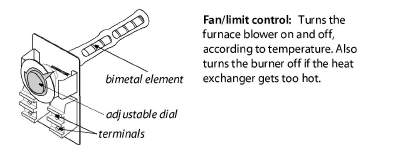
Duct Improvements to Increase Airflow
Consider specifying the following duct changes to increase system airflow and reduce the imbalance between supply airflow and return airflow.
✓ Modify the filter installation to allow easier filter changing, if filter changing is currently difficult.
✓ Install a slanted filter bracket assembly or an enlarged filter fitting to accommodate a larger filter with more surface area and less static-pressure drop compared to the existing filter.
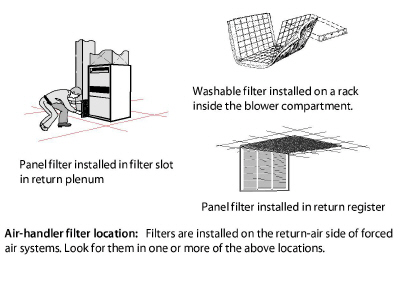
✓ Remove obstructions to registers and ducts such as rugs, furniture, and objects placed inside ducts (children’s toys and water pans for humidification, for example).
✓ Remove kinks from flex duct, and replace collapsed flex duct and fiberglass duct board.
✓ Remove excessive lengths of slacking flex duct, and stretch the duct to enhance airflow.
✓ Perform a Manual D sizing evaluation to evaluate whether to replace branch ducts that are too small.
✓ Install additional supply ducts and return ducts as needed to provide heated air throughout the building, especially in additions to the building.
✓ Undercut bedroom doors, especially in homes without return registers in bedrooms.
✓ Repair or replace bent, damaged, or restricted registers. Install low-resistance registers and grilles.
8.13.6 Air Filtration for Air Handlers
Manufacturers equip air handlers with air filters at the factory or recommend that installers install air filters in return ductwork. The purpose of these filters is to protect the blower and heat exchangers from fouling by dust.
Another possible function for air filters is to remove particles from indoor air. This function is useful when the outdoor environment contains a lot of particles, such in large cities, rural areas where wind and agriculture create particulates, or during forest fires.
The most common filter-rating method is the Minimum Efficiency Rating Value (MERV). A higher MERV rating means that the filter removes more particles and a larger fraction of smaller particles.
The MERV rating system divides particles into three size categories: 0.3–1, 1–3, and 3–10 microns. The two smallest categories are the most important for human health, as small respirable particles (PM2.5) can more easily deposit in the lungs compared to larger particles.
The need for high MERV filters depends on the severity of the particle problem in a building. Particles less than 2.5 microns are the most dangerous because they can lodge themselves deep in the lungs. Filtering air with a long-running central air handler or a portable air cleaner can be energy intensive and it may or may not be effective.
The MERV ratings of available HVAC filters range from MERV 3 to MERV 16, with higher ratings removing more particles at smaller sizes. A MERV 3 filter captures large particles — clothing fibers, pollen, and dust mites, but few smaller respirable particles. A MERV16 filter captures more than 95% of all three particle sizes, including bacteria and tobacco smoke. The minimum MERV rating to remove 50% of the respirable 1–3 microns particle-size range is MERV 10. See also Air Filtration for Indoor Air Quality
Air Filter Pressure and Airflow Effects
Air filters affect the airflow and energy consumption of forced air HVAC systems and balanced ventilation systems. Before choosing the type of air filter, consider its MERV rating and a home’s need for particle removal.
HVAC designers designed air handlers for use with low-MERV filters with a small pressure drop. Changing to higher-MERV filters can cause the filter pressure drop to increase and the system airflow to decrease.
Insufficient airflow may cause blowers to fail prematurely as they struggle to overcome system pressures beyond their design specification. For heating systems, the furnaces may overheat and cycle on their high limit switches. Airflow reductions in cooling systems risk coil icing and premature compressor failure. See also Air Filtration for Indoor Air Quality
To reduce the resistance of an high-MERV air filter, consider installing steps to accommodate a larger filter with more surface area and less static-pressure drop compared to the existing filter.
• A slanted filter bracket assembly
• An enlarged filter fitting to allow a filter with more surface area
• Filters in each return register instead of only one at the air handler.
8.14 Evaluating Duct Air Leakage
Duct leakage is a major energy-waster in homes where the ducts are located outside the home’s thermal boundary in a crawl space, attic, attached garage, or leaky unconditioned basement. When these intermediate zones remain outside the thermal boundary, duct sealing is usually cost-effective.
Duct leakage within the thermal/pressure boundary isn’t usually a significant energy problem.
8.14.1 Troubleshooting Duct Leakage
There are several simple procedures for finding the locations of the duct leaks and evaluating their severity.
Finding Duct Leaks Using Touch and Sight
One of the simplest ways of finding duct leaks is feeling with your hand for air leaking out of supply ducts, while the ducts are pressurized by the air handler’s blower. Duct leaks can also be located using light. Use one of these 4 tests to locate air leaks.
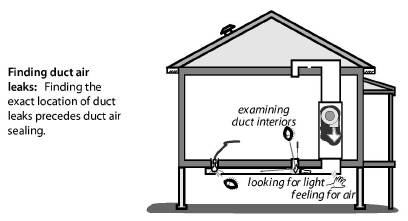
1. Use the air handler blower to pressurize supply ducts. Closing the dampers on supply registers temporarily or partially blocking the register with pieces of carpet, magazines, or any object that won’t be blown off by the register’s airflow increases the duct pressure and make duct leaks easier to find. Dampening your hand makes your hand more sensitive to airflow, helping you to find duct air leaks.
2. Place a trouble light, with a 100-watt bulb, inside the duct through a register. Look for light emanating from the exterior of duct joints and seams.
3. Determine which duct joints were difficult to fasten and seal during installation. These joints are likely duct-leakage locations.
4. Use a trouble light, flashlight, and mirror or a digital camera to help you to visually examine duct interiors.
Feeling air leaks establishes their exact location. Ducts must be pressurized in order to feel leaks. You can feel air leaking out of pressurized ducts, but you can’t feel air leaking into depressurized return ducts. Use tracer smoke to help find these leaks. Pressurizing the home with a blower door forces air through duct leaks, located in intermediate zones, where you can feel the leakage coming out of both supply and return ducts.
Pressure pan tests can identify leaky or disconnected ducts located in intermediate zones. With the house depressurized by the blower door to either –25 pascals or –50 pascals, make pressure pan readings at each supply and return register.
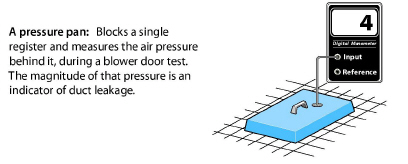
If the ducts are in a basement and the basement is conditioned, pressure pan testing isn’t necessary, although air sealing the return ducts for safety is still important.
If instead, the basement is unconditioned, close any openings between the basement and conditioned space. Measure and record the zone pressure of the basement with reference to the conditioned space before pressure pan testing.
1. Install blower door and set-up house for winter conditions. Open all interior doors.
2. If the basement is conditioned living space, open the door between the basement and upstairs living spaces.
3. If the basement isn’t conditioned living space, close the door between basement and upstairs. Then open a door or window between the basement and outdoors.
4. Turn furnace off at the thermostat or main switch. Remove furnace filter, and temporarily tape filter slot if one exists. Be sure that all grilles, registers, and dampers are fully open.
5. Temporarily seal any outside fresh-air intakes to the duct system.
6. Seal supply registers in unoccupied zones that aren’t intended to be heated — an unconditioned basement or crawl space, for example.
7. Open attics, crawl spaces, and garages as much as possible to the outdoors so they don’t create a secondary air barrier.
8. Connect hose between pressure pan and the input tap on the digital manometer. Leave the reference tap open.
9. With the blower door’s manometer reading –25 or –50 pascals, place the pressure pan completely over each grille or register one by one to form a tight seal. Leave all other grilles and registers open when making a test. Record each reading, which should give a positive pressure.
10. If a grille is too large or a supply register is difficult to cover with the pressure pan (under a kitchen cabinet, for example), seal the grille or register with masking tape. Insert a pressure probe through the masking tape and record the reading. Remove the tape after the test.
11. Use either the pressure pan or tape to test each register and grille in a systematic way.

If the ducts are perfectly sealed with no leakage to the outdoors, you won’t measure any pressure difference (0.0 pascals) during a pressure-pan test. The higher the measured pressure reading, the more connected the duct is to the outdoors.
• If the median pressure pan reading is 4 pascals or more and/or if one reading is more than 8 pascals, duct-sealing is usually cost-effective.
• Following duct-sealing work, no more than three registers should have pressure-pan readings greater than 2 pascals. No single reading should be greater than 4 pascals.
• The reduction you achieve depends on your ability to find the leaks and whether you can access the leaky ducts. The best weatherization agencies use 1 pascal or less as a general goal for all registers.
Examine the registers connected to ducts that are located in areas outside the conditioned living space. Unconditioned spaces containing ducts include attics, crawl spaces, garages, and unoccupied basements. Also evaluate registers attached to stud cavities or panned joists used as return ducts. Leaky ducts, located outside the conditioned living space, may lead to pressure-pan measurements more than 30 pascals if these ducts have large holes.
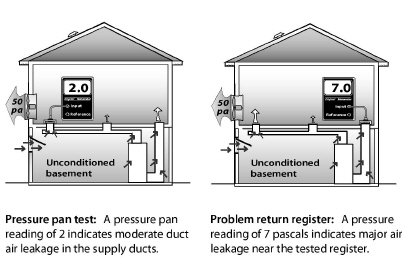
8.14.2 Measuring Duct Air Leakage with a Duct Blower
Pressurizing the ducts with a duct blower measures total duct leakage. The duct blower is the most accurate common measuring device for duct air leakage. It consists of a fan, a digital manometer or set of analog manometers, and a set of reducer plates for measuring different leakage levels. Using a blower door with a duct blower measures leakage to outdoors.


Measuring Total Duct Leakage
The total duct leakage test measures leakage to both indoors and outdoors. The house and intermediate zones should be open to the outdoors by way of windows, doors, or vents. Opening the intermediate zones to outdoors insures that the duct blower is measuring only the ducts’ airtightness — not the airtightness of ducts combined with other air barriers like roofs, foundation walls, or garages.
Supply and return ducts can be tested separately, either before the air handler is installed in a new home or when an air handler is removed during replacement.
Follow these steps when performing a duct airtightness test.
1. Install the duct blower in the air handler or to a large return register, either using its connector duct or simply attaching the duct blower itself to the air handler or return register with cardboard and tape.
2. Remove the air filter(s) from the duct system.
3. Seal all supply and return registers with masking tape or other non-destructive sealant.
4. Open the house, basement or crawl space, containing ducts, to outdoors.
5. Drill a 1/4 or 5/16-inch hole into a supply duct a short distance away from the air handler and insert a manometer hose. Connect a manometer to this hose to measure duct with reference to (WRT) outdoors. (Indoors, outdoors, and intermediate zones should ideally be opened to each other in this test).
6. Connect an airflow manometer to measure fan WRT the area near the fan.
Check manometer(s) for proper settings. Digital manometers require your choosing the correct mode, range, and fan-type settings.
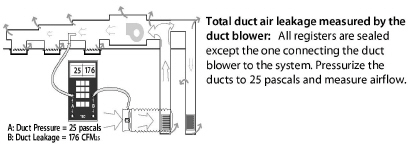
1. Turn on the duct blower and pressurize the ducts to +25 pascals.
2. Record duct-blower airflow.
3. While the ducts are pressurized, start at the air handler and move outward feeling for leaks in the air handler, main ducts, and branches.
4. After testing and associated air-sealing are complete, restore filter(s), remove seals from registers, and check air handler.
Measuring Duct Leakage to Outdoors
Measuring duct leakage to outdoors gives you a duct-air-leakage value that is directly related to energy waste and the potential for energy savings.
1. Set up the home in its typical heating and cooling mode with windows and outside doors closed. Open all indoor conditioned areas to one another.
2. Install a blower door, configured to pressurize the home.
3. Connect the duct blower to the air handler or to a main return duct.
4. Pressurize the ducts to +25 pascals by increasing the duct blower’s speed until this value is reached.
5. Pressurize the house until the pressure difference between the house and duct is 0 pascals (house WRT ducts). See Blower-Door Test Procedures
6. Read the airflow through the duct blower. This value is duct leakage to outdoors.
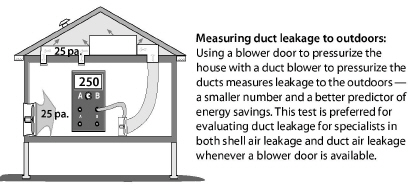
8.14.3 Measuring House Pressure Caused by Duct Leakage
The following test measures pressure differences between the house and outdoors, caused by duct leakage. Try to correct pressure differences greater than +2.0 pascals or more negative than –2.0 pascals because of the shell air leakage that the pressure differences create.
1. Close all windows and exterior doors. Turn-off all exhaust fans.
2. Open all interior doors, including door to basement.
3. Measure the baseline house-to-outdoors pressure difference and zero it out using the baseline procedures described in Blower-Door Test Procedures.
4. Turn on air handler.
5. Measure the house-to-outdoors pressure difference. This test indicates dominant duct leakage as shown here.
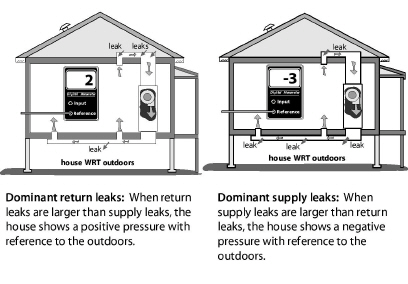
A positive pressure indicates that the return ducts (which pull air from leaky intermediate zones) are leakier to the outdoors than the supply ducts. A negative pressure indicates that the supply ducts (which push air into intermediate zones through their leaks) are leakier than return ducts. A pressure at or near zero indicates equal supply and return leakage or else little duct leakage.
Ducts located outside the thermal boundary or in an intermediate zone like a ventilated attic or crawl space should be sealed. The following is a list of duct leak locations in order of their relative importance. Leaks nearer to the air handler are exposed to higher pressure and are more important than leaks further away.
8.15.1 General Duct-Sealing Methods
Duct sealers install duct mastic and fiberglass mesh to seal duct leaks. When they need reinforcement or temporary closure, the duct sealers use tape or sheet metal. Observe these three standards.
1. Seal seams, cracks, joints, and holes, less than ¼ inch using mastic and fiberglass mesh.
2. Bridge seams, cracks, joints, holes, and penetrations, between ¼ and ¾ inch, with sheet metal or tape and then cover the metal or tape completely with mastic reinforced by mesh at seams in the sheet metal or tape.
3. Overlap the mastic and mesh at least 0ne inch beyond the seams, repairs, and reinforced areas of the ducts.
Return leaks are important for combustion safety and for efficiency. Use the following techniques to seal return ducts.
✓ First, seal all return leaks within the combustion zone to prevent this leakage from depressurizing the combustion zone and causing spillage.
✓ Seal all return ducts in crawl spaces for indoor air quality.
✓ Seal panned return ducts using mastic to seal all cracks and gaps within the return duct and register.
✓ Seal leaky joints between building materials composing cavity return ducts, like panned floor cavities and furnace return platforms. Remove the panning to seal cavities containing joints in building materials.
✓ Carefully examine and seal leaks at transitions between panned floor joists and metal trunks that change the direction of the return ducts. You may need a mirror to find some of the biggest return duct leaks in these areas.
✓ Seal filter slots with a tight-fitting, durable, user-friendly filter-slot cover to allow easy removal for filter-changing.
✓ Seal the joint between the furnace and return plenum with silicone caulking or foil tape.
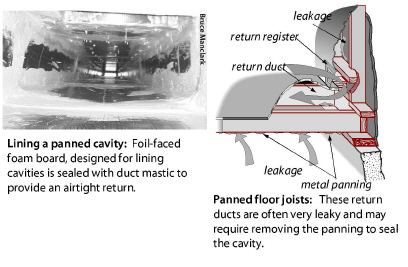
|
SWS Detail: 3.1602.1 Air Sealing Duct System, 3.1602.5 Return—Framed Platform, 3.1602.4 Air Sealing System Components, 3.1601.8 Preparation and Mechanical Fastening—Mid and High Rise, 3.1602.7 Return and Supply Plenums in Basements and Crawl Spaces, 3.1601.3 Support |
Inspect these places in the duct system and seal them as needed.
✓ Plenum joint at air handler: Technicians might have had problems sealing these joints because of a lack of space. Seal these plenum connections thoroughly even if you must cut an access hole in the plenum. Use silicone caulking or foil tape instead of mastic and fabric mesh here for future access — furnace replacement, for example.
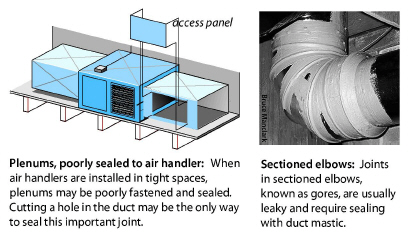
✓ Joints at branch takeoffs: Seal these important joints with a thick layer of mastic. Fabric mesh tape should cover gaps and reinforce the seal at gaps.
✓ Joints in sectioned elbows: Known as gores, these are usually leaky and require sealing with duct mastic.
✓ Tabbed sleeves: Attach the sleeve to the main duct with 3-to-5 screws and apply mastic plentifully. Or better, remove the tabbed sleeve and replace it with a manufactured takeoff.
✓ Flexduct-to-metal joints: Apply a 2-inch band of mastic to the end of the metal connector. Attach the flexduct’s inner liner with a plastic strap, tightening it with a strap tensioner. Attach the insulation and outer liner with another strap.
✓ Damaged flex duct: Replace flex duct when it is punctured, deteriorated, or otherwise damaged.
✓ Deteriorating ductboard facing: Replace ductboard, preferably with metal ducting, when the facing deteriorates because this deterioration leads to a lot of air leakage.
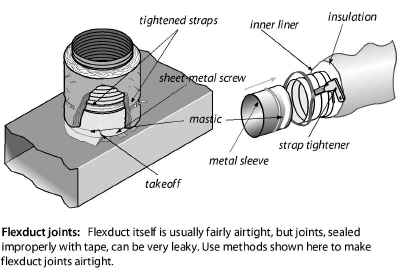
✓ Consider closing supply and return registers in unoccupied basements or crawl spaces.
✓ Seal penetrations made by wires or pipes traveling through ducts.
✓ Seal the joint between the boot and the ceiling, wall, or floor between conditioned and unconditioned areas.
Duct Support
✓ Support rigid ducts and duct joints with duct hangers at least every 5 feet or as necessary to prevent sagging of more than one-half inch.
✓ Support flexible ducts and duct board every 4 feet using a minimum of 1 ½” wide support material.
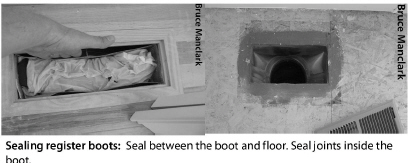
8.15.4 Materials for Duct Sealing
Duct mastic is the best duct-sealing material because of its superior durability and adhesion. Apply mastic at least 1/16-inch thick, and use reinforcing mesh for all joints wider than 1/8-inch or joints that may move. Install screws to prevent joint movement or separation.
Aluminum foil or cloth duct tape aren’t good materials for duct sealing because their adhesive often fails. Consider covering tape with mastic to prevent tape’s adhesive from drying out and failing.
|
SWS Detail: 4.1601.1 Insulating Flex Ducts, 4.1601.2 Insulating Metal Ducts |
Insulate supply ducts that are installed in unconditioned areas outside the thermal boundary such as crawl spaces, attics, and attached garages with vinyl- or foil-faced duct insulation. Don’t insulate ducts that run through conditioned areas unless they cause overheating in winter or condensation in summer. Use these best practices for installing insulation.
✓ Always perform necessary duct sealing before insulating ducts.
✓ Duct-insulation R-value must be equal to or greater than R-8.
✓ Insulation should cover all exposed supply ducts, with no significant areas of bare duct left uninsulated.
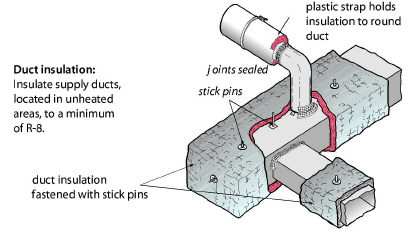
✓ Insulation’s compressed thickness must be more than 75% of its uncompressed thickness. Don’t compress duct insulation excessively at corner bends.
✓ Fasten insulation using mechanical means such as stick pins, twine, staples, or plastic straps.
✓ Cover the insulation’s joints with tape to stop air convection. However, tape often falls off if the installer expects tape to support the insulation’s weight.
✓ Install the duct insulation 3 inches away from heat-producing devices such as recessed light fixtures.
Caution: Burying ducts in attic insulation is common in some regions and it reduces energy losses from ducts. However, condensation on ducts in humid climates is common during the air-conditioning season, so don’t allow cellulose to touch metal ducts to avoid corrosion from cellulose’s Borate fire retardant.
Important Note: Tape can be effective for covering joints in the insulation to prevent air convection, but the tape fails when expected to resist the force of the insulation’s compression or weight. Outward-clinch staples or plastic straps can help hold the insulation facing and tape together.
8.16.1 Spray Foam Duct Insulation
|
SWS Details: 3.1602.2 Duct Spray Polyurethane Foam (SPF) Installation |
High-density spray foam insulation is also a good duct-insulation option, assuming it is listed as ASTM E-84 or UL 723. Spray foam is particularly helpful in areas where the foam can seal seams and insulate in one application. However, the spray foam application is limited by space around the duct to a greater amount than wrapping with fiberglass blankets.
8.17 Hot-Water Space-Heating Distribution
The most significant energy wasters in hot-water systems are poor steady-state efficiency, off-cycle flue losses stealing heat from the stored water, and boilers operating at a too-high water temperature. For information about boiler installation, see this location.
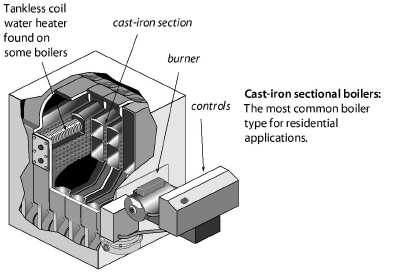
8.17.1 Boiler Efficiency and Maintenance
|
SWS Details: 5.3104.2 Maintenance: Gas Boiler Service Inspection, 2.0203.3 Combustion Air—Boilers |
Monitor boiler performance and efficiency in the following ways.
• Corrosion, scaling, and dirt on the water side of the heat exchanger.
• Corrosion, dust, and dirt on the fire side of the heat exchanger.
• Excess air during combustion from air leaks and incorrect fuel-air mixture.
• Off-cycle air circulation through the firebox and heat exchanger, removing heat from stored water.
Boiler Efficiency Improvements
Consider the following maintenance and efficiency improvements for both hot-water and steam boilers based on boiler inspection.
✓ Check for leaks on the boiler, around its fittings, or on any of the distribution piping connected to the boiler.
✓ Clean fire side of heat exchanger of noticeable dirt.
✓ Drain water from the boiler drain until the water flows clean.
8.17.2 Hydronic Distribution System Improvements
Hydronic distribution systems consist of the supply and return piping, the circulator, expansion tank, air separator, air vents, and heat emitters. A properly designed and installed hydronic distribution system can operate for decades without service. However, many systems have installation flaws or need service.
Note: You can recognize a hot-water boiler by its expansion tank, located somewhere above the boiler. The expansion tank provides an air cushion to allow the system’s water to expand and contract as it is heated and cooled. Without a functioning expansion tank excessive pressure in the boiler discharges water through the pressure-relief valve.
Safety Checks and Improvements
Work with contractors and technicians to specify and verify the following safety and efficiency tests and inspections.
✓ Verify the existence of a 30-psi-rated pressure relief valve. The pressure relief valve should have a drain pipe that terminates 6 inches from the floor. Replace a malfunctioning valve, or install a pressure relief valve if none exists. Look for signs of leakage or discharges. Find out why the pressure relief valve is discharging.
✓ Verify that the expansion tank isn’t waterlogged or isn’t too small for the system. A waterlogged expansion tank can make the pressure relief valve discharge. Measure the expansion tank’s air pressure. A common pressure for one and two-story buildings is 12 psi. The pressure in taller buildings should be approximately one (1) psi per 2.3 feet of the distribution system’s height.
✓ If you observe rust in venting, verify that the return water temperature is warmer than 130°F for gas and warmer than 140°F for oil. These minimum water temperatures prevent acidic condensation.
✓ Verify that high-limit control disengages the burner at a water temperature of 200°F or less.
✓ Lubricate circulator pump(s) if necessary.
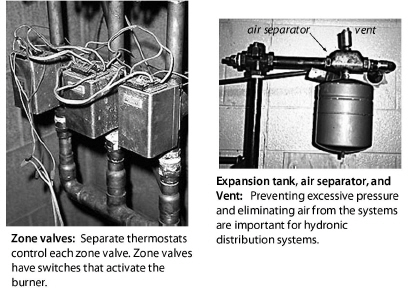
Simple Efficiency Improvements
Do the following energy-efficiency improvements.
✓ Repair water leaks in the system.
✓ Remove corrosion, dust, and dirt on the fire side of the heat exchanger.
✓ Check for excess air during combustion from air leaks and incorrect fuel-air mixture.
✓ Bleed air from radiators and piping through air vents on piping or radiators. Most systems fill automatically through a shutoff and pressure-reducing valve connected to the building’s water supply. If there is a shutoff and no pressure-reducing valve, install one and set it to the hydronic-system pressure. Then check the system pressure at the expansion tank, and adjust the pressure as necessary.

✓ Vacuum and clean fins of fin-tube convectors if you notice dust and dirt there.
✓ Insulate all supply and return piping, passing through unheated areas, with foam pipe insulation, at least one-inch thick, rated for temperatures up to 200° F.
Improvements to Boiler Controls
Consider these improvements to control systems for hot-water boilers.
✓ Install outdoor reset controllers to regulate water temperature, depending on outdoor temperature.
✓ If possible, operate the boiler without a low-limit control for maintaining a minimum boiler-water temperature. If the boiler heats domestic water in addition to space heating, the low-limit control may be necessary.
✓ After control improvements like two-stage thermostats or reset controllers, verify that return water temperature is high enough to prevent condensation and corrosion in the chimney as noted previously.
✓ Install electric vent dampers on natural-draft gas- and oil-fired high-mass boilers.
8.18 Steam Heating and Distribution
Steam heating is less efficient than hot-water heating because steam requires higher temperatures than hot water. For single-family homes, consider replacing a steam heating system with a hot-water or forced-air system. Multifamily buildings, especially multi-story buildings, may have little choice but to continue with steam because of the high cost of switching systems.
Note: You can recognize a steam boiler by its sight glass, which indicates the boiler’s water level. Notice that the water doesn’t completely fill the boiler, but instead allows a space for the steam to form above the boiler’s water level.
If the steam-heating system remains, operate it at the lowest steam pressure that heats the building adequately. Two psi on the boiler-pressure gauge is a practical limit for many systems although some systems can operate at pressures down to a few ounces per square inch of pressure. Traps and air vents are crucial to operating at a low steam pressure. Electric vent dampers reduce off-cycle losses for both gas- and oil-fired systems.
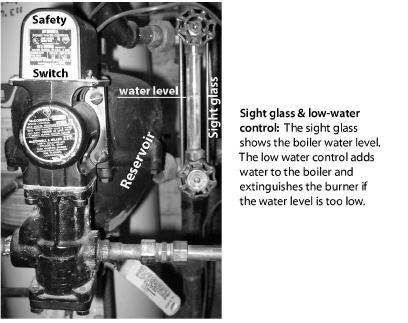
8.18.2 Steam System Maintenance
Do these safety and maintenance tasks on steam systems.
✓ Verify that steam boilers have functioning high-pressure limits and low-water cut-off controls.
✓ Verify the function of the low-water cutoff by flushing the low-water cutoff with the burner operating. Combustion should stop when the water level in the boiler drops below the level of the float. If combustion continues, repair or replace the low-water cutoff.
✓ Verify that flush valves on low-water cutoffs are operable and don’t leak water.
✓ Ask owner about instituting a schedule of blow-down and chemical-level checks.
✓ Specify that technicians drain mud legs on return piping.
8.18.3 Steam System Energy Conservation
|
SWS Details: 5.3104.14 Tuneup and Upgrades 5.3104.3 Maintenance: Checklist, 5.3104.8 Boiler Water Treatment, 5.3104.9 Inspection Checklist, 5.3102.32 Install Thermostatic Radiator Valves |
Specify the following efficiency checks and improvements for steam systems.
One-Pipe Steam
✓ Verify that high-pressure limit control is set at or below 1 (one) psi or as low as acceptable in providing heat to the far ends of the building.
✓ Verify that steam reaches all radiators during every steam cycle. Steam need not fill radiators on every cycle. In mild weather, steam partly fills radiators before the boiler cycles off.
✓ Radiator air vents should be open to release air while the system is filling with steam, then closed when steam reaches the vents. Replace malfunctioning radiator air vents as necessary. However, don’t over-vent radiators because this can cause water hammer.
✓ Verify air vents function and that all steam radiators receive steam during every cycle. Unplug air vents or replace malfunctioning vents as necessary. Add vents to steam lines and radiators as needed to get steam to all the registers.
Two-Pipe Steam
✓ When you can gain access to all the system’s steam traps, repair leaking steam traps or replace them. All failed traps should be replaced at the same time to prevent new traps failing because of water hammer from steam leakage through neighboring failed traps. The only 100% reliable way to test a steam trap is to connect it to a test apparatus and see if it allows steam to pass. However if you have an accurate thermometer, the temperature on the radiator side of a functioning trap should be more than 215°F and the temperature on the return side of that trap should be less than 205°F when steam is in the radiator.
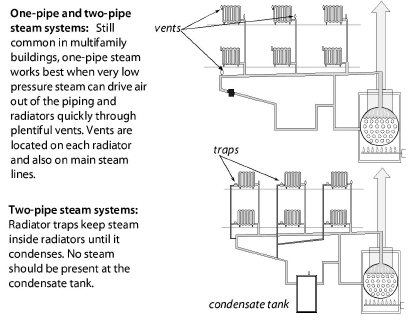
✓ When you can’t gain access to all the system’s steam traps at the same time, consider abandoning failed steam traps and installing radiator-inlet orifices in two-pipe steam radiators. The orifices limit steam flow to an amount that can condense within the radiator. Orifices can also reduce steam delivery to oversized radiators by 20% or a little more.
✓ Consider controlling radiators with thermostatic radiator valves (TRVs) except for radiators in the coolest rooms. TRVs can be used with systems equipped with either traps or orifices. For effective temperature control, the thermostatic element of the TRVs must be located in the path of air moving toward the radiator or convector. TRVs are available with sensors located remotely from the valve, which solves the problem of a valve located where the radiator heats a valve-mounted sensor, fooling it into closing.
✓ Inspect return lines and condensate receiver for steam coming back to the boiler. Check radiator and main line traps.
✓ Check steam traps with a digital thermometer or listening device to detect any steam escaping from radiators through the condensate return. Replace leaking steam traps or their thermostatic elements.
✓ Consider installing remote sensing thermostats that vary cycle length according to outdoor temperature and include night-setback capability.
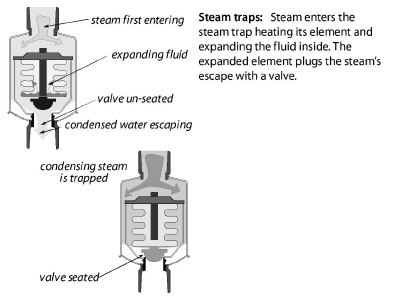
✓ Repair leaks on the steam supply piping or on condensate return piping.
✓ Consider a flame-retention burner and electric vent damper as retrofits for steam boilers.
✓ Clean fire side of heat exchanger of noticeable dirt.
✓ All steam piping that passes through unconditioned areas should be insulated to at least R-3 with fiberglass or specially designed foam pipe insulation rated for steam piping.
A programmable thermostat may be a big energy saver if the building’s occupants understand how to program it. However, a programmable thermostat won’t save any energy if occupants already control day and night temperatures effectively.
If you replace the existing thermostat, as a part of weatherization work, discuss programmable thermostats with occupants. If they can use a programmable thermostat effectively, then install one. Educate occupants on the use of the thermostat and leave a copy of manufacturer’s directions with them.
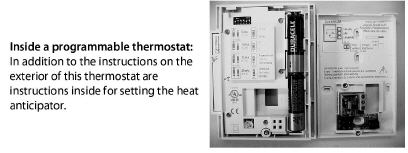
Many models of programmable thermostats have settings that you select from inside the thermostat. These settings include the heat-anticipator setting, which adjusts the cycle length of the heating or cooling system.
|
SWS Detail: 5.3003.4 Evaluating Electrical Service, 5.3003.26 Electrical Service—Mid and High Rise |
Electric heaters are usually 100% efficient at converting the electricity to heat in the room where they are located.
8.20.1 Electric Baseboard Heat
Electric baseboard heaters are zonal heaters controlled by thermostats within the zone they heat. Electric baseboard heat can help to minimize energy costs, if residents take advantage of the ability to heat by zones.
Baseboard heaters contain electric resistance heating elements encased in metal pipes. These are surrounded by aluminum fins to aid heat transfer. As air within the heater is heated, it rises into the room. This draws cooler air into the bottom of the heater.
• Make sure that the baseboard heater sits at least an inch above the floor to facilitate good air convection.
• Clean fins and remove dust and debris from around and under the baseboard heaters as often as necessary.
• Avoid putting furniture directly against the heaters. To heat properly, there must be space for air convection.
The line-voltage thermostats used with baseboard heaters sometimes don’t provide good comfort. This is because these thermostats allow the temperature in the room to vary by 2°F or more. Newer, more accurate thermostats are available. Programmable thermostats for electric baseboard heat use timers or a resident-activated button that raises the temperature for a time and then automatically returns to the setback temperature. Some baseboard heaters use low-voltage thermostats connected to relays that control baseboard heaters in rooms.
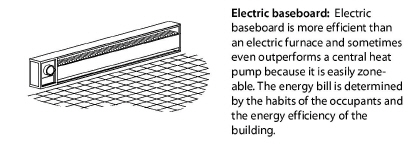
Electric furnaces heat air moved by its fan over several electric-resistance heating elements. Electric furnaces have two to six elements — 3.5 to 7 kW each — that work like the elements in a toaster. The 24-volt thermostat circuit energizes devices called sequencers that bring the 240 volt heating elements on in stages when the thermostat calls for heat. The variable speed fan switches to a higher speed as more elements engage to keep the air temperature stable.
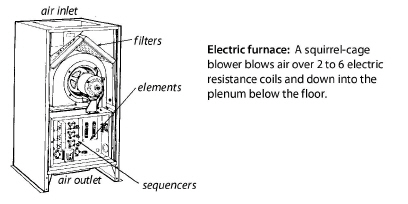
8.20.3 Central Heat-Pump Energy Efficiency
|
SWS Detail: 5.3003.4 Evaluating Electrical Service, 5.3003.26 Electrical Service—Mid and High Rise, 5.3002.12 Cooling Equipment—Installation, Maintenance, and Commissioning— Mid and High Rise |
An air-source heat pump is almost identical to an air conditioner, except for a reversing valve that allows refrigerant to follow two different paths, one for heating and one for cooling. Heat pumps move heat with refrigeration rather than converting it from the chemical energy of a fuel.
Like air conditioners, air-source heat pumps are available as centralized units with ducts or as room units. Heat pumps are 1.5 to 3 times more efficient than electric furnaces. Heat pumps can provide competitive comfort and value with combustion furnaces, but they must be installed with great care and planning.
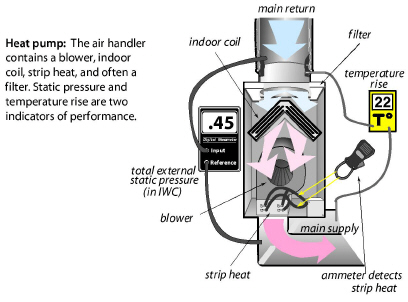
Heat pumps are also equipped with auxiliary electric resistance heat, called strip heat. The energy efficiency of a heat pump depends on how much of the heating load the compressor provides without using the strip heat.
Evaluating Heat Pumps During the Heating Season
Heat pumps should have two-stage thermostats designed for use with heat pumps. The first stage is compressor heating and the second stage is the inefficient strip heat. Evaluating heat pumps in the winter is more difficult than a summer evaluation.
Although we can generally evaluate the heat pumps refrigerant charge in the winter, it may be necessary to return in warm weather to more accurately charge the system. This summer verification is required with new heat-pump installations.
Consider these steps to evaluate heat pumps during the winter.
✓ Measure the airflow of the air handler by temperature rise method, flow plate or flow hood. Heat pumps must have 400-450 CFM per ton for efficient operation. (One ton of refrigeration = 12,000 BTUH)
✓ Look for a temperature rise of 20°F when the outdoor temperature is 32°F. Add or remove 1° of temperature rise for every 3° it is over or under 32°F outdoor.
✓ Check for operation of strip heat by measuring amperage. Then use the chart shown here to find out if strip heat is operating.

✓ External static pressure should be 0.5 IWC (125 pascals) or less for older, fixed-speed blowers and less than 0.8 IWC (200 pascals) for variable-speed blowers. Lower external static pressure promotes higher airflow.
✓ Seal supply and return ducts and insulate them after you’ve verified the airflow as adequate. Measure airflow again after duct sealing.
Most residential central heat pumps are split systems with the indoor coil and air handler indoors and outdoor coil and compressor outdoors. Individual room heat pumps are more efficient since they don’t have ducts, and are factory-charged with refrigerant. The illustrations show features of an energy-efficient heat pump installation.
In the summer, use the same procedures to evaluate central heat pumps as to evaluate central air conditioners, described on this location. .
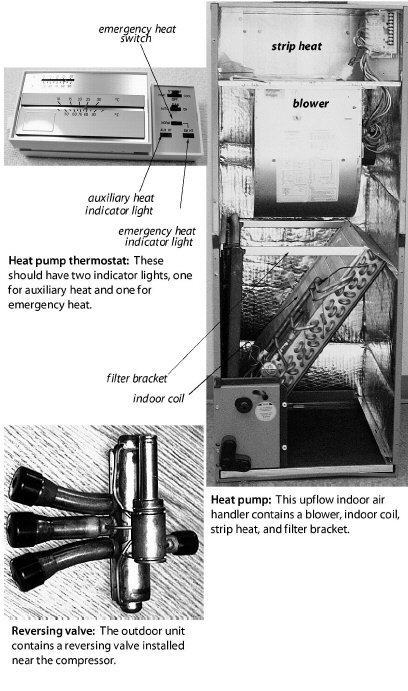
The illustration shows features of an energy-efficient heat pump installation.
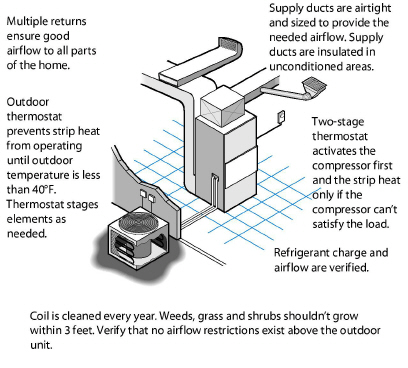
|
SWS Detail: 5.3003.4 Evaluating Electrical Service, 5.3302.1 Through-Wall and Room Air Conditioning Unit Replacement, 5.3003.26 Electrical Service—Mid and High Rise |
Room heat pumps can provide all or part of the heating and cooling needs for small homes. These one-piece room systems (also known as terminal systems) look like a room air conditioner, but provide heating as well as cooling. They can also provide ventilation air when neither heating nor cooling are required. They mount in a window or through a framed opening in a wall.
Room (or unitary) heat pumps can be a good choice for replacing existing unvented gas space heaters. Their fuel costs may be somewhat higher than gas furnaces, though they are safer and require less maintenance than combustion appliances. Room heat pumps also gain some overall efficiency because they heat a single zone and don’t have the delivery losses associated with central furnaces or central boilers. If they replace electric resistance heat, they consume only one-half to one-third the electricity to produce the same amount of heat.
Room heat pumps draw a substantial electrical load, and may require 240-volt wiring. Provide a dedicated circuit that can supply the equipment’s rated electrical input. Insufficient wiring capacity can result in dangerous overheating, tripped circuit breakers, blown fuses, or motor-damaging voltage drops. In most cases a licensed electrician should confirm that the house wiring is sufficient. Don’t run portable heat pumps or any other appliance with extension cords or plug adapters.
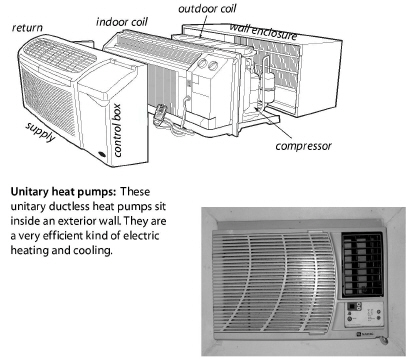
8.20.5 Ductless Minisplit Pumps
|
SWS Detail: 5.3003.4 Evaluating Electrical Service, 5.3003.26 Electrical Service—Mid and High Rise |
Ductless minisplit heat pumps contain an outdoor condenser and one or more indoor fan-coil units that heat or cool the rooms. Mini-split heat pumps are among the most efficient heating and cooling systems available, providing 2-to-4 watt hours of heating or cooling for each watt hour of electricity they use. Specify minisplits heat pumps as replacement HVAC solutions when they are appropriate, for example.
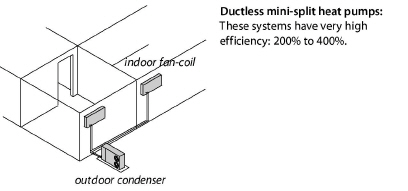
• Homes currently having no ducts.
• Homes with poorly designed or deteriorating ducts outside the thermal boundary or located in inaccessible areas, such as floor cavities.
• Isolated part of a building such as an addition or a bonus room.
• Very well-insulated, airtight, and shaded homes.
• Bedrooms needing cooling in homes with no central air conditioning.
• Masonry buildings being retrofitted to replace obsolete central space-conditioning systems (often steam).
8.21 Evaluating Ducted Central Air-Conditioning Systems
|
SWS Detail: 5.3003.4 Evaluating Electrical Service, 5.3003.26 Electrical Service—Mid and High Rise |
An energy-efficient home shouldn’t need more than a ton of air-conditioning capacity for every 1000 square feet of floor space. Window shading, attic insulation, and air leakage should be evaluated together with air-conditioner performance.
The following four installation-related problems are characteristic of central air conditioning systems.
1. Inadequate airflow
2. Duct air leakage
3. Incorrect charge
4. Oversizing
Refrigerant-charge tests and adjustment come after airflow measurement and improvement, and after duct testing and sealing. Manufacturers recommend that you verify adequate airflow before checking and adjusting the refrigerant charge.
The recommended airflow rate for central air-conditioning systems is between 350 CFM and 450 CFM per ton of refrigeration capacity. Heat pump airflow rate should be between 400 CFM and 450 CFM per ton.
|
Installation-Related Problem |
%B |
Savings Potential |
|---|---|---|
|
Duct air leakage (avg. 270 CFM25)C |
70% |
17% avg. |
|
Inadequate airflow |
70% |
7% avg. |
|
Incorrect charge |
74% |
12% avg. |
|
Oversized by 50% or more |
47% |
2–10% |
|
AReport sponsored by Environmental Protection Agency (EPA) and compiled from research from Multiple Field Studies BPercent of tested homes found with a significant problem. CThe number of homes of the duct-leakage studies was around 14,000; the number for the other problems was over 400 each. |
8.21.1 Central Air-Conditioner Inspection
|
SWS Detail: 5.3003.7 Occupant Education, 2.0702.2 Occupant Education, 2.0702.3 Building Operations Staff Education |
Air conditioners move a lot of air, and that air contains dust. The filter in the air handler catches most large dust. However some dust travels around or through the filter, depending on the filter and its mounting assembly. The condenser coil outdoors isn’t protected by a filter and is usually quite dirty.
Cleaning the Condenser Coil
Dirt enters the coil from the outside. The goal of this procedure is to drive the dirt out by spraying inside to outside. With high-pressure water, however, you can drive the dirt through the coil and into the cabinet where it drains out through drain holes.
✓ Inspect the condenser coil and know that it is probably dirty even if it looks clean on the outside. Take a flat toothpick and scrape between the fins. Can you scrape dirt out from between the fins?
✓ Apply a biodegradable coil cleaner to the outside of the coil. Then spray cold water through the coil, preferably from inside the cabinet. Many coils can tolerate a high-pressure spray but others need low-pressure spray to avoid bending the fins.
✓ Straighten bent fins with a fin comb.
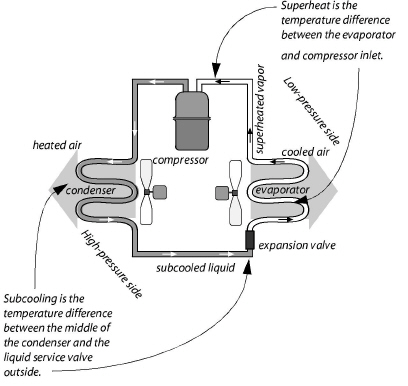
Cleaning the Evaporator Coil
Dirt enters the filter, blower, and coil from the return plenum.
✓ Inspect the filter slot in the air handler or the filter grille in the return air registers. Do the filters completely fill their opening? Are the filters dirty?
✓ Inspect the blower in the air handler after disconnecting power to the unit. Can you remove significant dirt from one of the blades with your finger? If the blower is dirty, then the evaporator coil is also dirty.
✓ Clean the blower and evaporator. Rake surface dirt and dust off the coil with a brush. Then use an indoor coil cleaner and water to clean between the fins.
✓ Straighten bent fins with a fin comb.
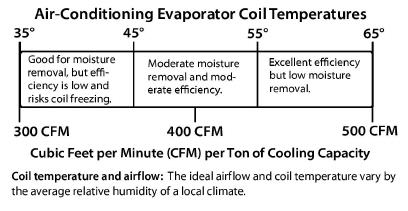
Calculate the correct size of an air conditioner before purchasing or installing it. The number of square feet of floor space that can be cooled by one ton of refrigeration capacity is determined by the home’s energy efficiency, solar gain and internal gain. Air-conditioners provide cooling most cost-effectively when they are sized accurately and run for long cycles.
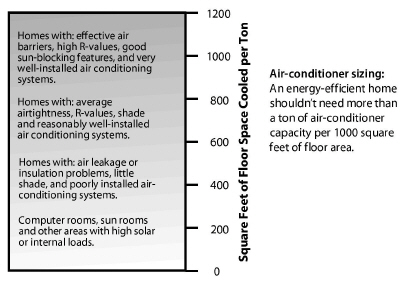
The cooling-cost reduction strategy should focus on making the home more energy efficient and making the air conditioner work more efficiently. Making the home more efficient involves shading, insulation, and air-leakage reduction. Making the air conditioner more efficient involves duct sealing, duct insulation, and a quality installation.
8.21.3 Duct Leakage and System Airflow
Unfortunately, duct leakage and poor airflow afflict most air-conditioning systems. The testing and mitigation of these problems was covered earlier in this chapter.
1. See Evaluating Duct Air Leakage
2. See Ducted Air Distribution
8.21.4 Evaluating Air-Conditioner Charge
|
SWS Detail:5.3003.23 Refrigerant Charge Evaluation—Low Rise, 5.3003.13 Refrigerant Charge Evaluation, 2.0302.1 Locking Refrigerant Caps—Mid and High Rise, 5.3003.5 Refrigerant Line Inspection |
Air-conditioning replacement or service includes refrigerant charge-checking. HVAC technicians evaluate refrigerant charge by two methods depending on what type of expansion valve the air conditioner has.
1. If the expansion valve has a fixed orifice, the technician performs a superheat test.
2. If the valve is a thermostatic expansion valve (TXV), the technician performs a subcooling test.
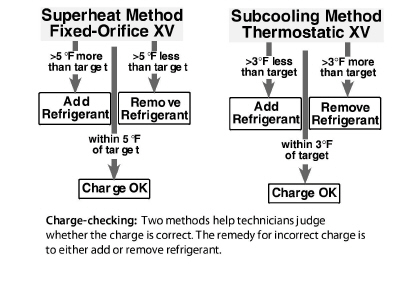
These two tests indicate whether the amount of refrigerant in the system is correct, or whether there is too much or too little refrigerant. The amount of refrigerant is directly related to the efficiency of the air-conditioning system.
Perform charge-checking after the airflow tests, airflow adjustments, and duct-sealing are complete. Do charge-checking during the cooling season while the air conditioner is operating.